The fascinating city of Nuremberg is definitely one of our favorite cities in the Franconia region. Not only does it offer numerous sights and historical treasures, but also a vibrant cultural scene, great restaurants and cafés, a variety of events, interesting world-class museums, and cool outdoor excursions.
For us, Nuremberg offers the complete package if you want to get a taste of “big city life” in the Franconia region for a few days. In the following article, we present our favorite Nuremberg sights and most beautiful highlights. Enjoy browsing!
- Interesting facts about the city of Nuremberg
- The most beautiful sights in Nuremberg
- Nuremberg’s neighborhoods + web app
- Restaurants & Cafés
- Events in Nuremberg
- Our hotel in Nuremberg
- Travel tips for Nuremberg
- Our Franconian podcast
Interesting facts about the city of Nuremberg
Nuremberg has a history of almost 1,000 years and was once an important center of the Holy Roman Empire. The city was an important site for imperial coronations and Reichstag meetings. After the end of World War II, the famous Nuremberg Trials took place in Nuremberg, in which leading National Socialists were accused of war crimes and crimes against humanity. These trials contributed to the development of modern international law. We highly recommend the book “Always Tell Your Truth” (order here*).
Did you know that Nuremberg is known for its long tradition of toy manufacturing? The city has a long history as a center for toy manufacturing, particularly wooden toys, dolls, and mechanical toys. Today, Nuremberg is also home to the world’s largest international toy fair. Be sure to stop by the Toy Museum.
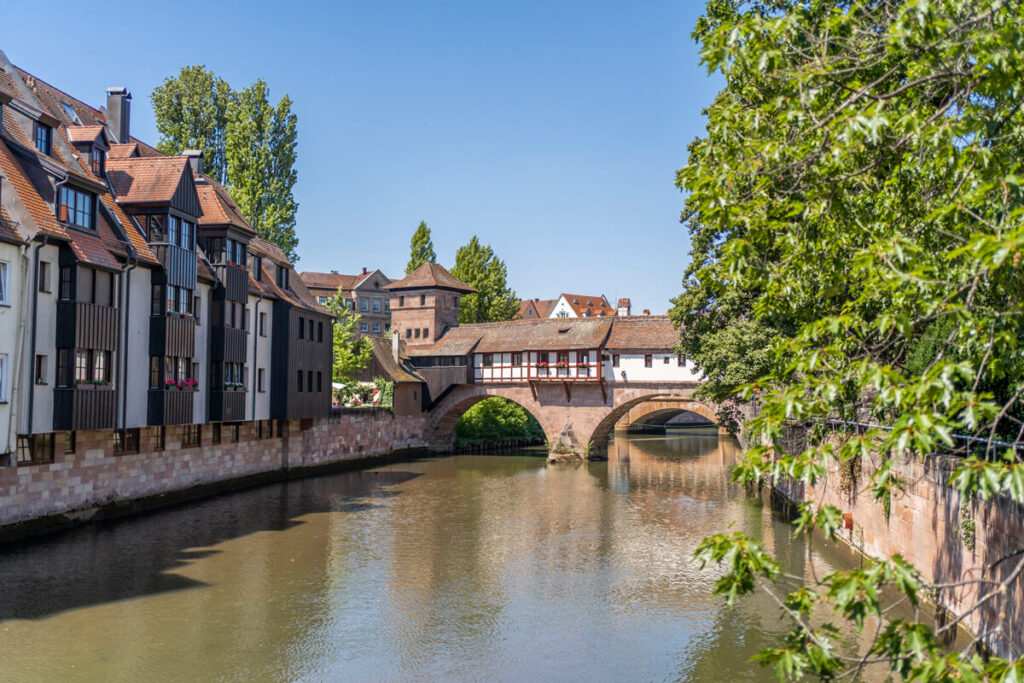
The imposing Imperial Castle towers over the city and is one of its most famous landmarks. Once the residence of the German emperors, it impresses visitors with its medieval architecture. A visit is a must. The famous German artist Albrecht Dürer was born in Nuremberg, and his former home is now a museum offering insights into his life and works.
The Nuremberg Christkindlesmarkt is one of the oldest and most famous Christmas markets in the world. It attracts visitors from all over the world every year and offers a festive atmosphere with traditional handicrafts, gingerbread, and mulled wine. The city is also known for its culinary delights, including Nuremberg bratwurst, gingerbread, and red beer. Further down in the article, we’ll introduce you to some cool locations.
The Most Beautiful Sights in Nuremberg
The city, with a rich history and diverse culture, offers a wealth of options, and the list of sights in Nuremberg is long. We’ve marked all the important spots for you on the map below.
If you only have one day, you should definitely focus on a few highlights. Just don’t try to explore the entire city, as that’s not possible in such a short time. We recommend at least 3 days for Nuremberg.
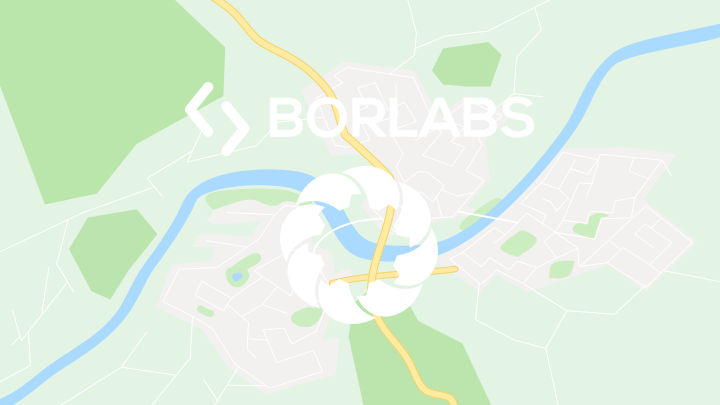
By loading the map, you accept Google’s privacy policy.
Learn more
Load map
1. Nuremberg Imperial Castle
The most famous sight in Nuremberg is the Imperial Castle, which towers majestically over the city and rises above the roofs of the old town. The imposing fortress, which has its roots in the 11th century, served as the residence of the German emperors of the Holy Roman Empire and as a site of important political events, imperial coronations, and Imperial Diets.
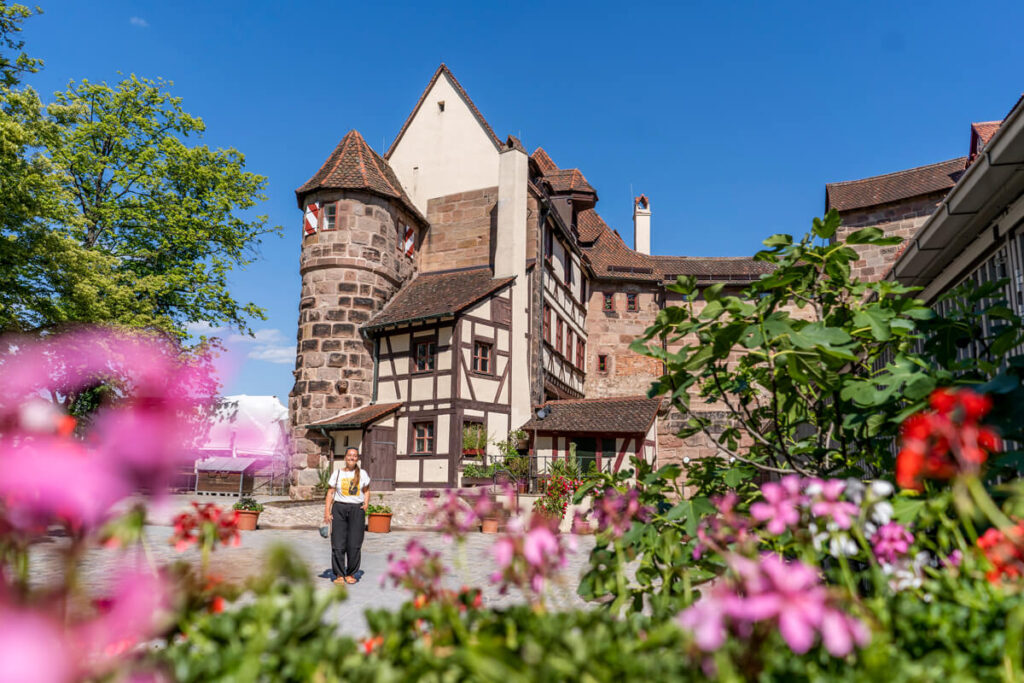
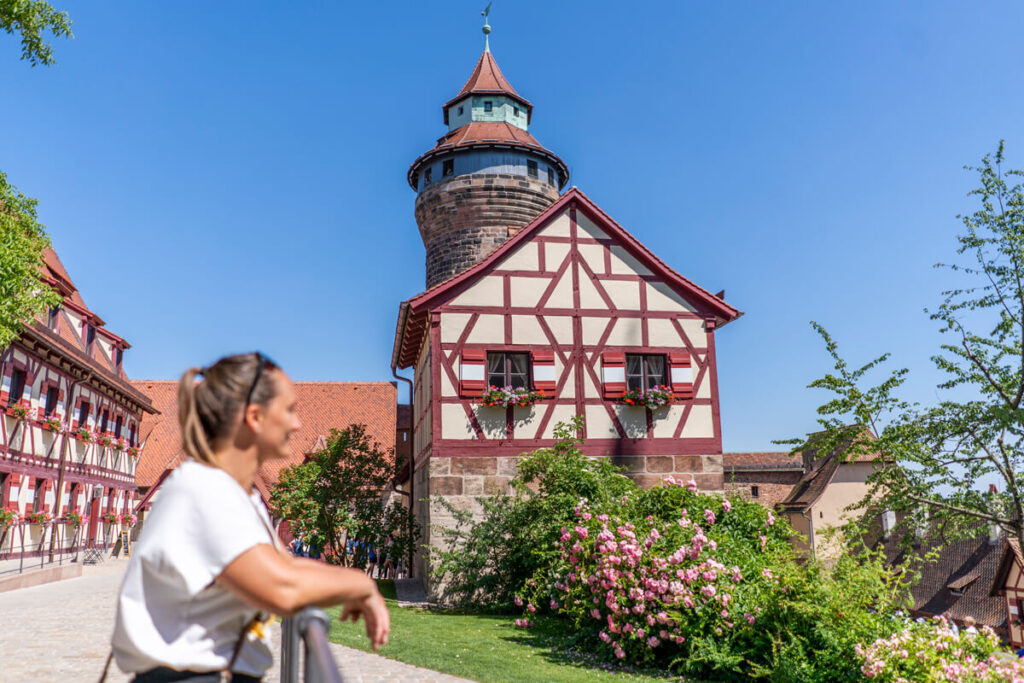
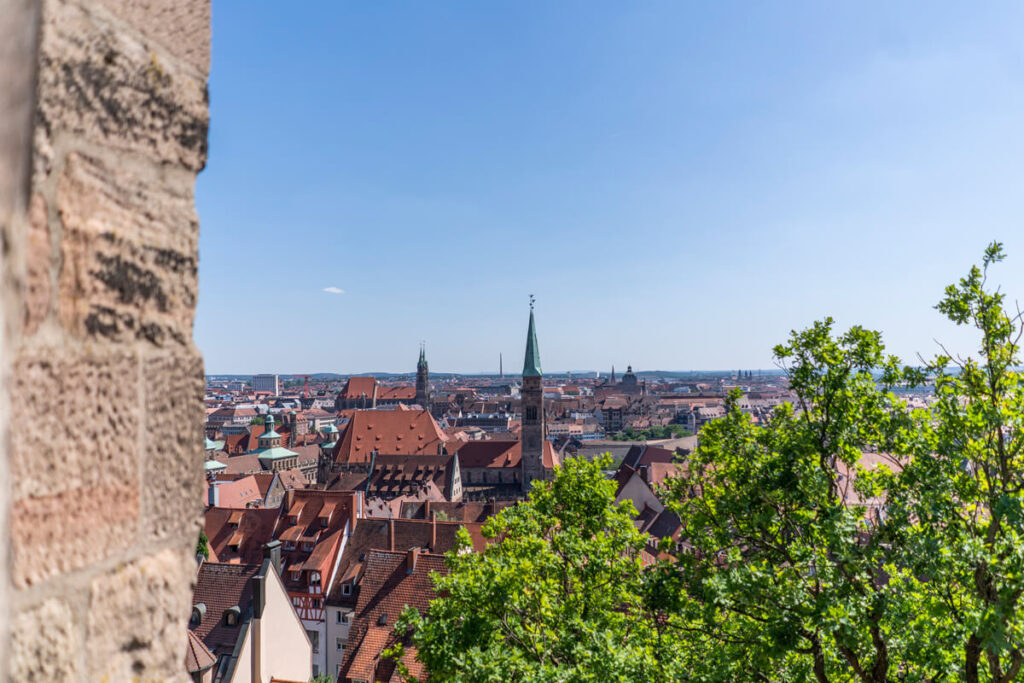
From the Tiergärtnertor, you can take a leisurely stroll to the castle and enjoy the view over Nuremberg. The view is particularly beautiful in the evening, once the sun has set. During the day, you can visit the Imperial Castle and view the museum, the exhibition in the Palas, and the Deep Well. We also recommend the view from the Sinwell Tower, which is located in the forecourt.
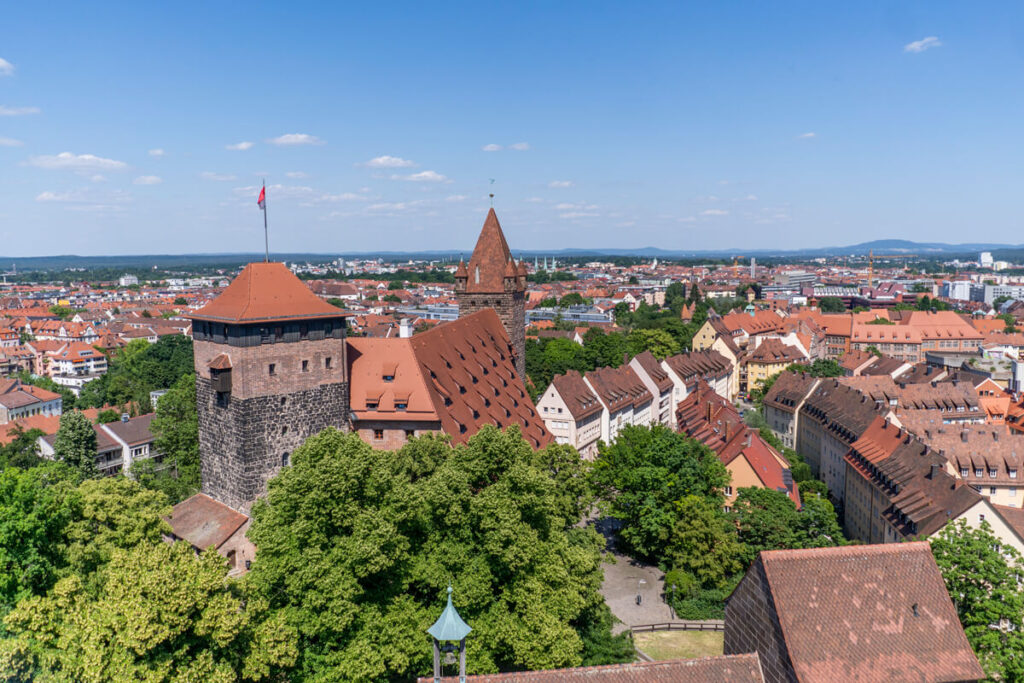
- Address: Burg 17, 90403 Nuremberg
- Opening times: April to October 3: 9 a.m. to 6 p.m. | October 4 to March: 10 a.m. to 4 p.m.
- Prices: €7 (Palace with Double Chapel, Kaiserburg Museum, Deep Well & Sinwell Tower)
- Children and young people up to the age of 18 receive free admission
- Tickets: order online here
2. The beautiful castle gardens
The majestic Imperial Castle is surrounded by green spaces, a moat, and an idyllic castle garden. In addition to lush flower meadows and rose gardens, you’ll also find some ancient trees lining the paths and providing shade. Here, you can briefly forget the hustle and bustle of the city and fully enjoy the idyllic scenery.
It’s best to start your exploration at the Tiergärtnertor gate and stroll through the southern castle garden toward the Imperial Castle. The castle garden is open from April 15th to October from 8 a.m. until dusk (until 8 p.m. at the latest).
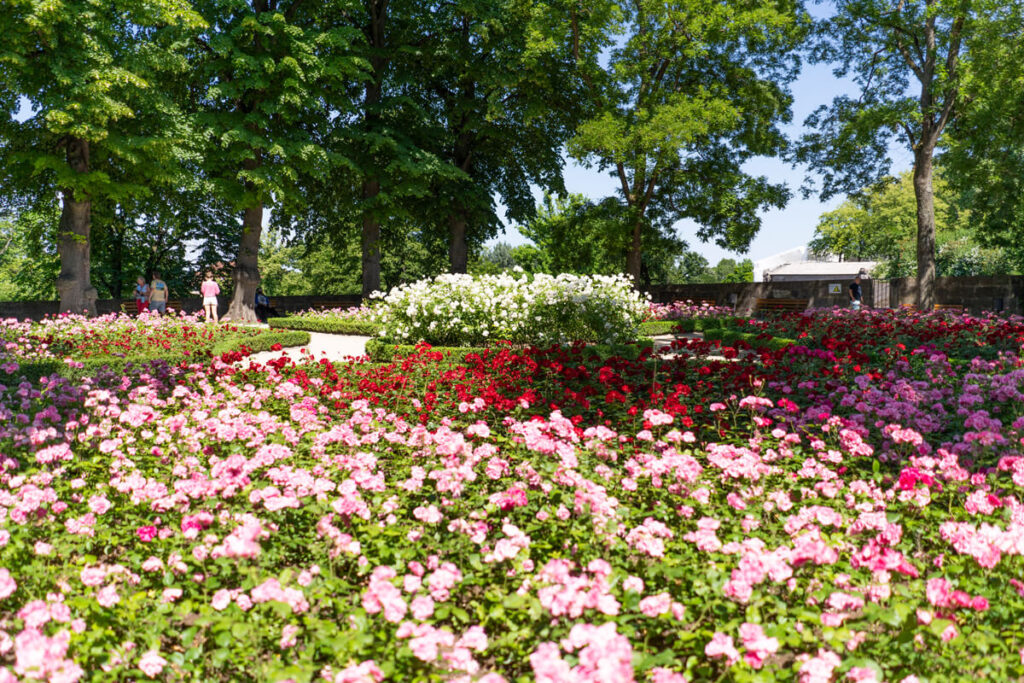
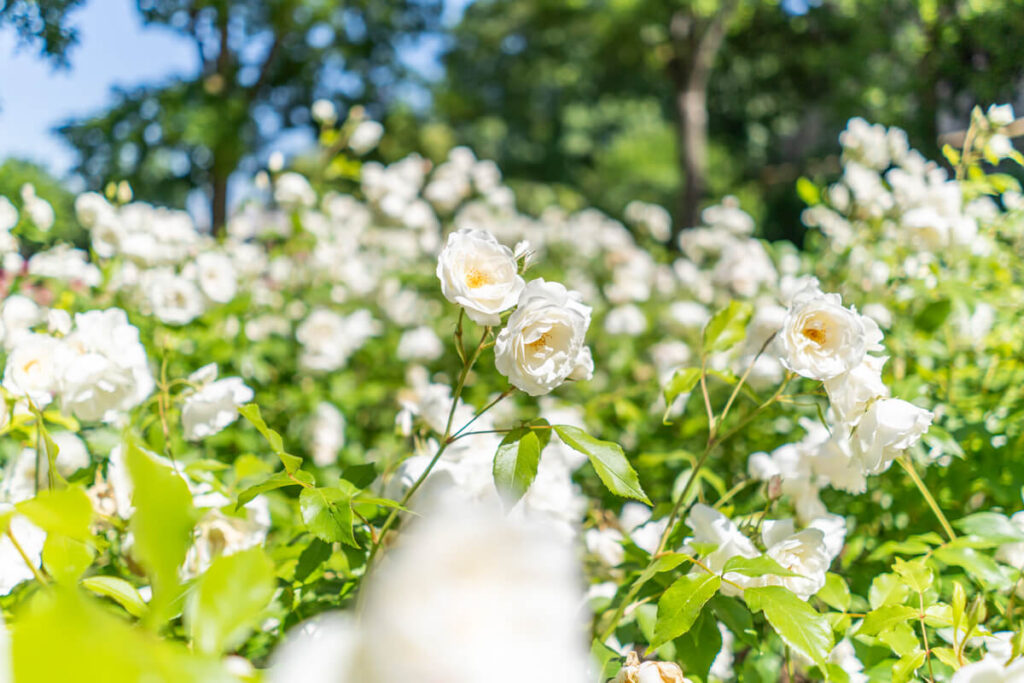
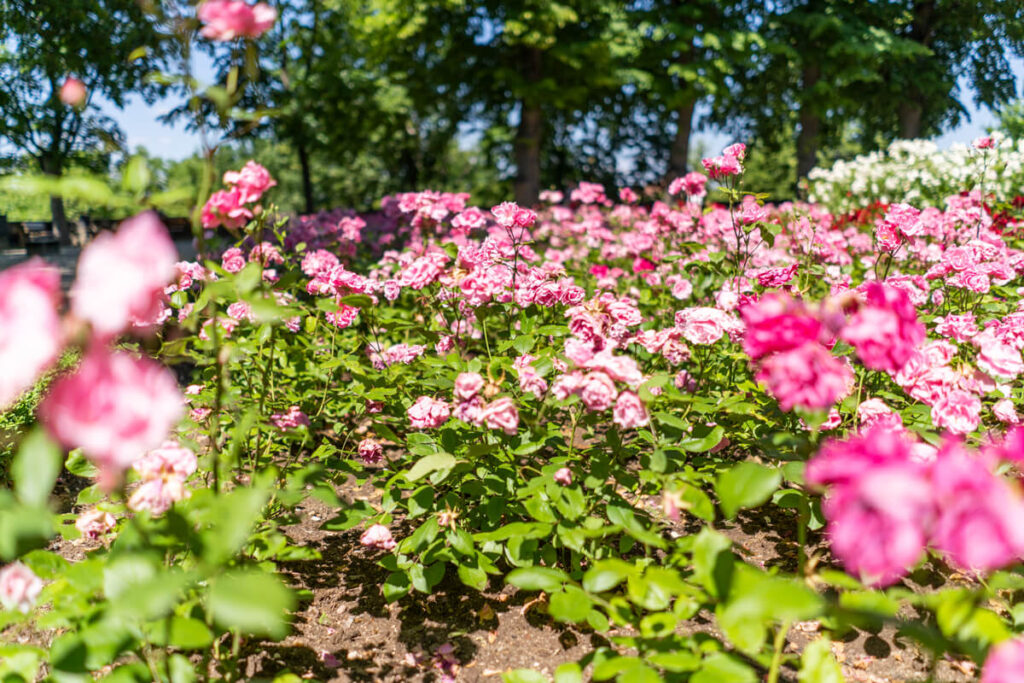
3. Around the Tiergärtnertor
A particularly beautiful area for us is the area around the Tiergärtnertor. The Tiergärtnertorplatz is a popular meeting place for young and old. There are also some really pretty half-timbered houses there, such as the Pilatushaus or the house opposite, where the restaurant “Zum Albrecht Dürer Haus” is located today.
Several restaurants are lined up here, as well as the popular Café Wanderer & Bieramt. Grab a glass of wine or a beer and make yourself comfortable in the square.
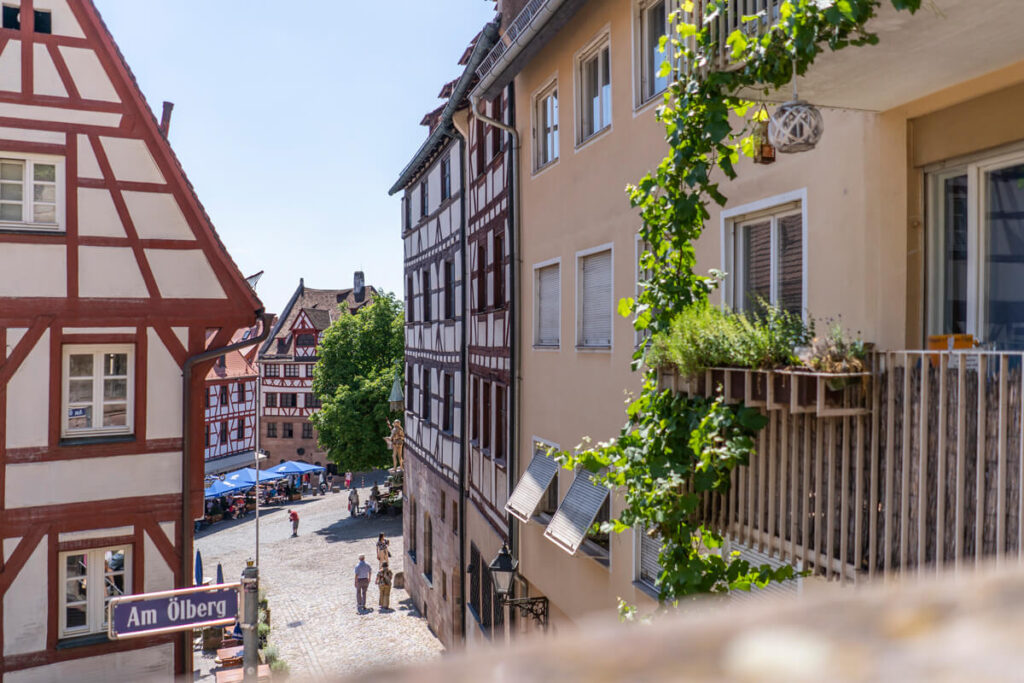
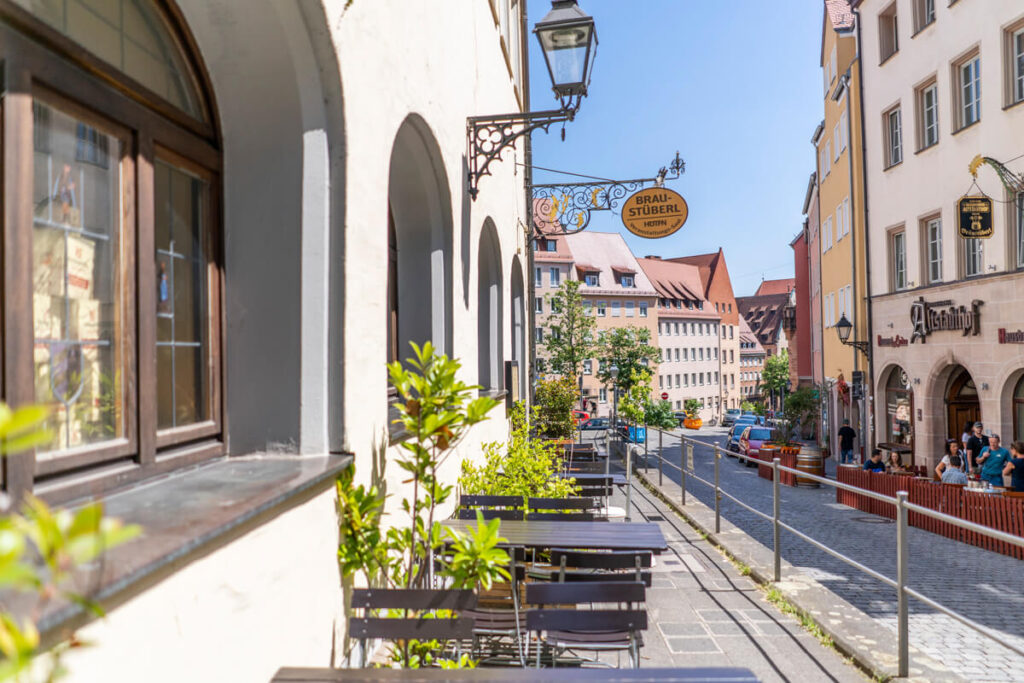
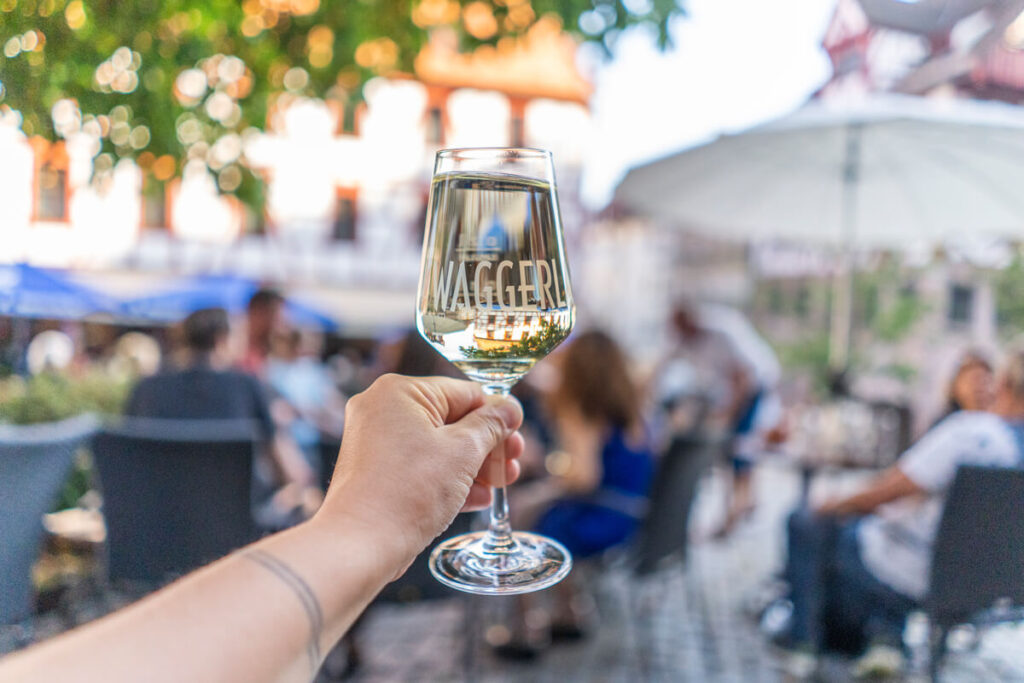
4. Underground Rock Passages
The underground rock passages of Nuremberg are a fascinating network of historic cellars and passageways that run deep beneath the city. This impressive subterranean world has a long history and played an important role in the storage of food, beer, and other goods over the past centuries. During a guided tour, we learned a lot about the history and use of these fascinating cellar spaces.
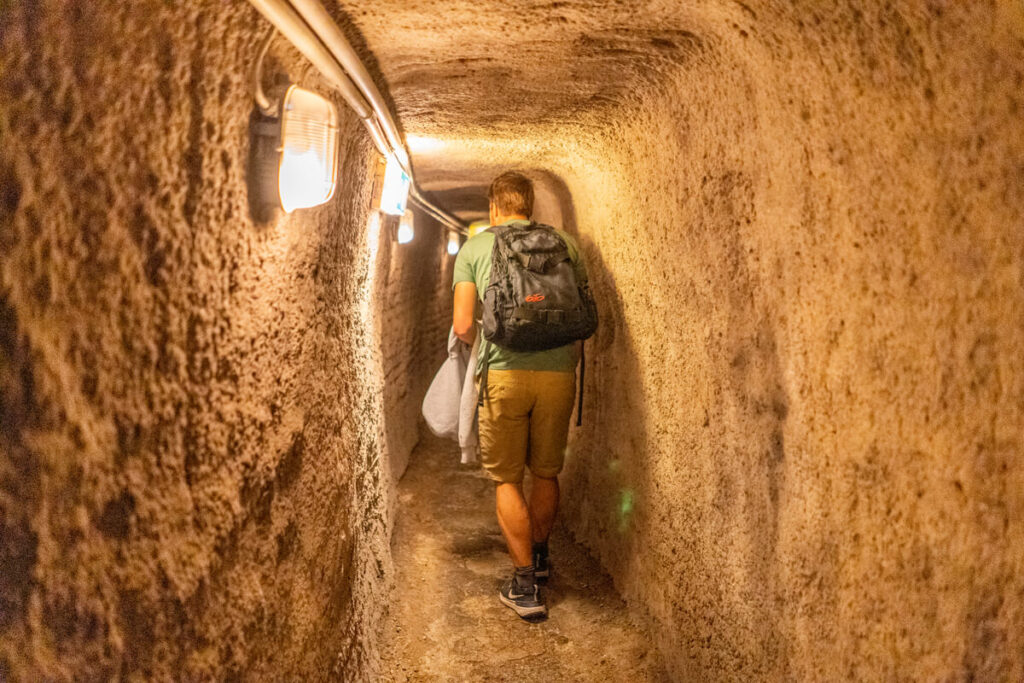
The rock cellars have their origins in the Middle Ages, when citizens of Nuremberg began digging cellars into the soft sandstone cliffs beneath the city. These cellar rooms were originally used to store food to protect it from heat, cold, and moisture. One of the most notable uses of the rock cellars was for beer storage. The constant temperature and humidity in the cellars provided ideal conditions for breweries to store and age their beer.
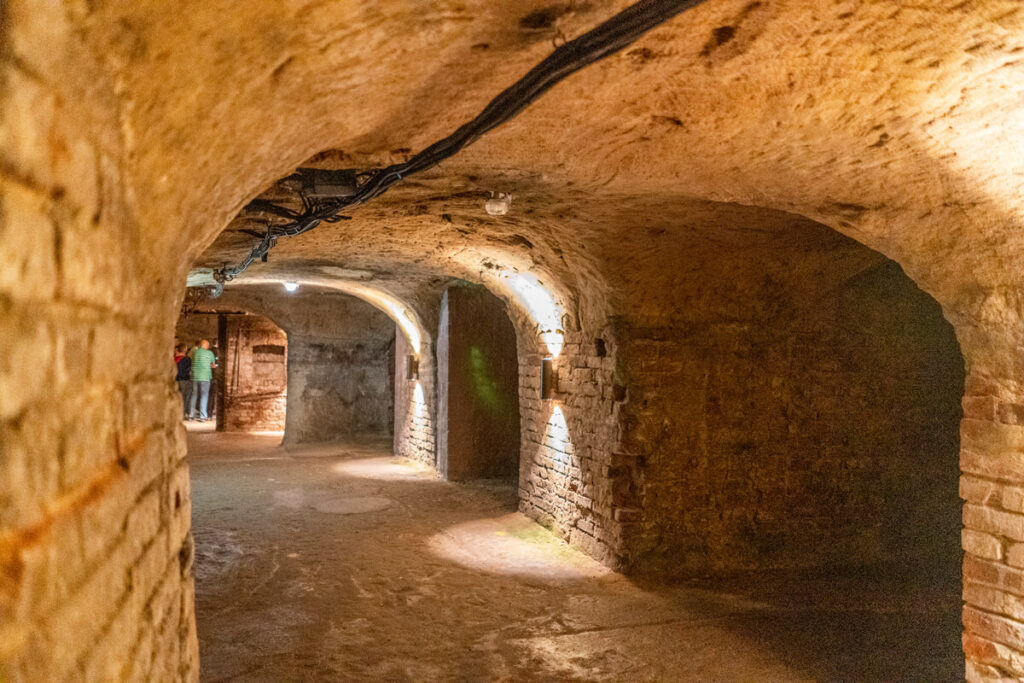
The network of rock cellars extends over a considerable area beneath Nuremberg’s Old Town. Many cellars are interconnected and located on different levels. Throughout their long history, the rock cellars have also been used for other purposes, including secret escape routes and hiding places during times of siege or political unrest. ☞ You can book your tour here for €12.
5. Weißgerbergasse
Weißgerbergasse is definitely one of the top sights in Nuremberg. This street is an extremely charming, historic alleyway, distinguished by its well-preserved medieval architecture and unique character. The alley owes its name to the tanners who once worked here, processing animal hides into leather.
The buildings along Weißgerbergasse are typical of medieval architecture in Nuremberg. The half-timbered houses are lined up closely together and have colorful facades. For us, this is definitely one of the most beautiful photo spots in the city. You’ll also find several cafés and restaurants here that invite you to feast. We can recommend, for example, the Bergbrand coffee roastery and the Kleine Eismanufaktur.
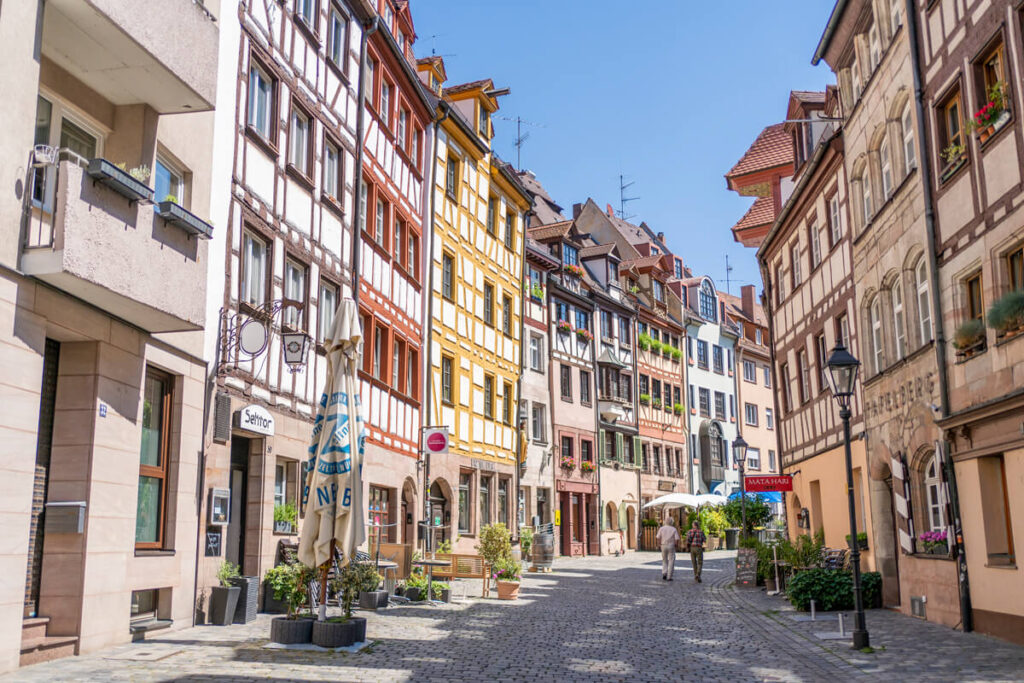
6. Wine Market & St. Sebaldus Church
If you stroll along Weißgerbergasse, you’ll automatically reach the Wine Market and the worth-seeing St. Sebaldus Church. Here you’ll find unique, owner-operated shops, such as the Auch wine shop. We particularly liked the open spaces, the huge wooden seating elements, the lovely plants, and the cozy atmosphere. Since cars are no longer allowed here, the area also has a traffic-calmed zone.
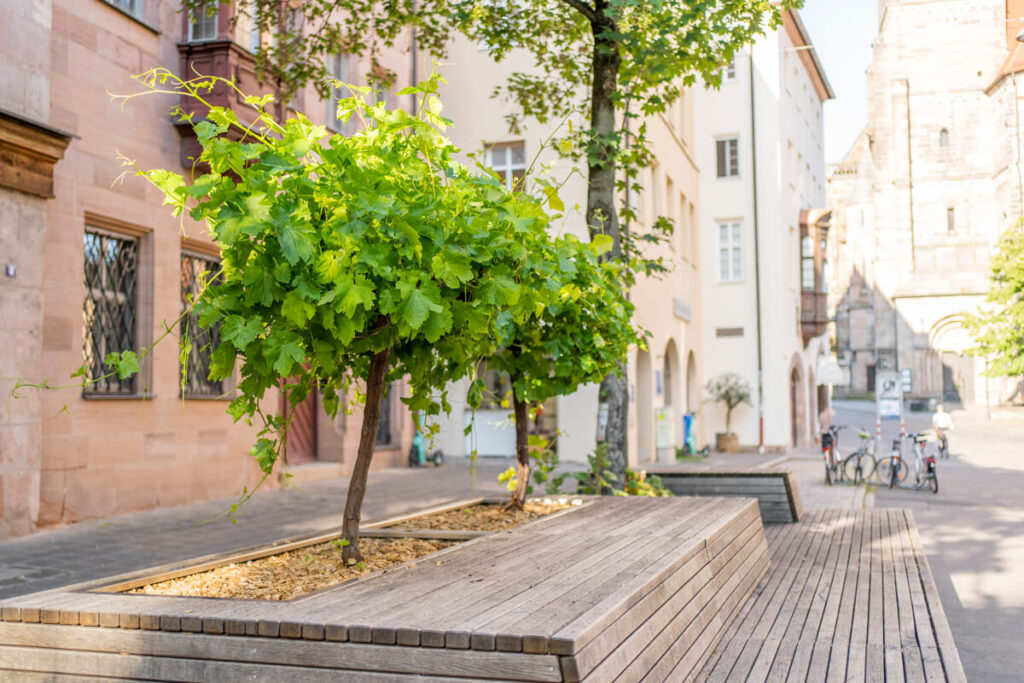
Directly next to the Weinmarkt is Nuremberg’s oldest parish church, the imposing St. Sebaldus Church. It is one of the city’s two main churches and was built between 1225/1230 and 1273 as a double-choir pillar basilica. Particularly worth seeing inside are the stained-glass windows, St. Peter’s Altar, and St. Sebaldus’s tomb. From April to December, the church is open daily from 9:30 a.m. to 6 p.m..
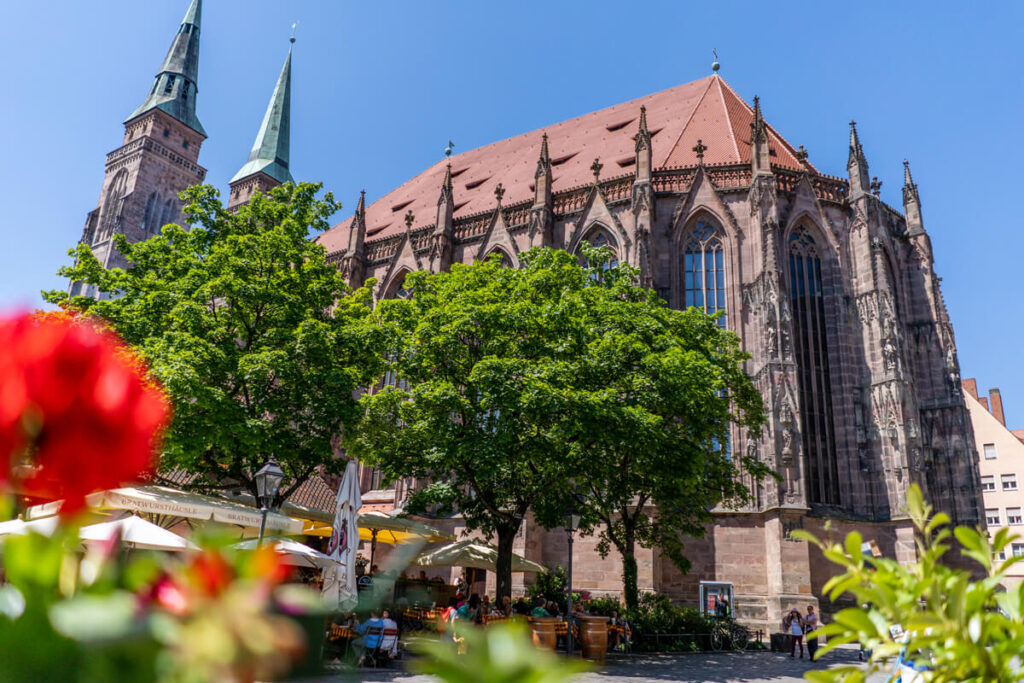
7. Henkersteg & Weinstadel
TheHenkersteg and the Weinstadel are historical landmarks in Nuremberg, which we consider to be among the top sights in Nuremberg. The Henkersteg, also known as the Hangman’s Bridge, is a pedestrian bridge that crosses the Pegnitz River. The bridge has a rich history and owes its name to the fact that it was used by the executioner to access the prison and torture chambers in the Hangman’s House. The Henkersteg is characterized by its charming medieval architecture and offers picturesque views of the river and the surrounding area.
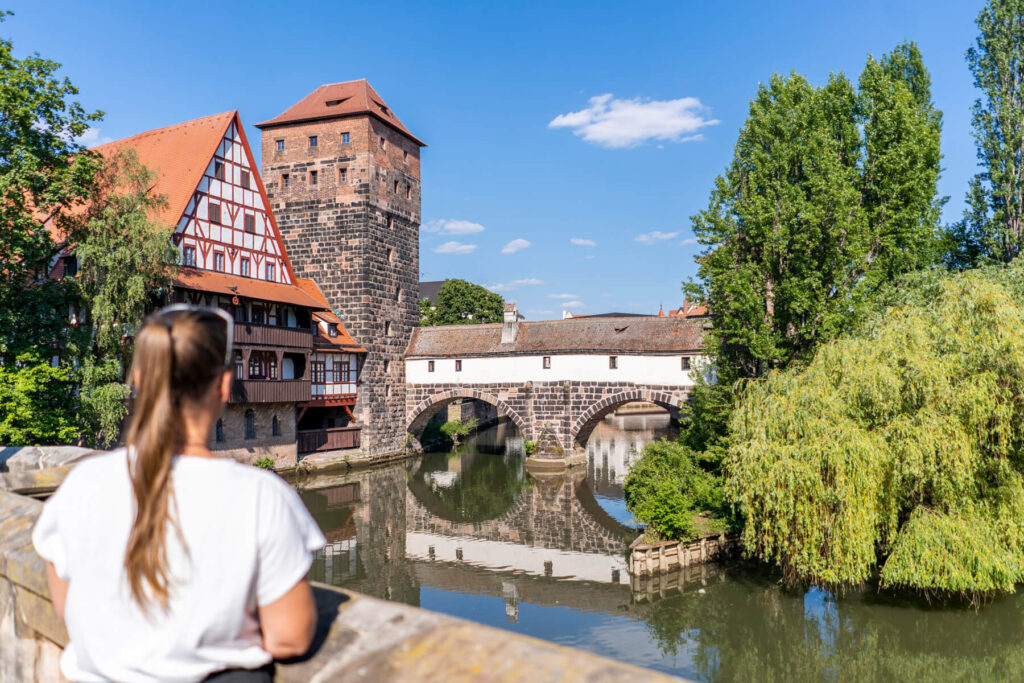
The Weinstadel is a historic building ensemble on the banks of the Pegnitz River. It was originally built in the 15th century and served as a storage facility for wine barrels, which is reflected in its name (“Weinstadel” means “wine grain store”). The building is 8 meters long, has two half-timbered floors and three additional floors under a gable roof. This makes it one of the largest half-timbered houses in Germany. Today, the Weinstadel is a modernly converted student residence. For us, this building complex is definitely one of the most beautiful photo spots in the city.
8. At the Flea Market
Over the Henkersteg, you now reach the small Pegnitz Island with its lovingly restored houses. Here at the flea market, you will find art galleries, restaurants, cafés, shops selling home accessories, fashion, jewelry, and much more. In the Middle Ages, pigs were once traded here; today, Venetian gondolas invite you to take a ride on the Liebesinsel (Love Island).
The small Bratwurstgasse also houses the Nuremberg Bratwurst Museum, where, of course, everything revolves around the Nuremberg delicacy. Next door, you’ll find incredibly delicious Elisenlebkuchen (gingerbread) at “Art und Delikat,” and souvenirs and delicacies for the palate at “Bisschen Mehr.” The delicatessen shop “Bisschen Mehr” offers a wide selection of souvenirs and delicacies.
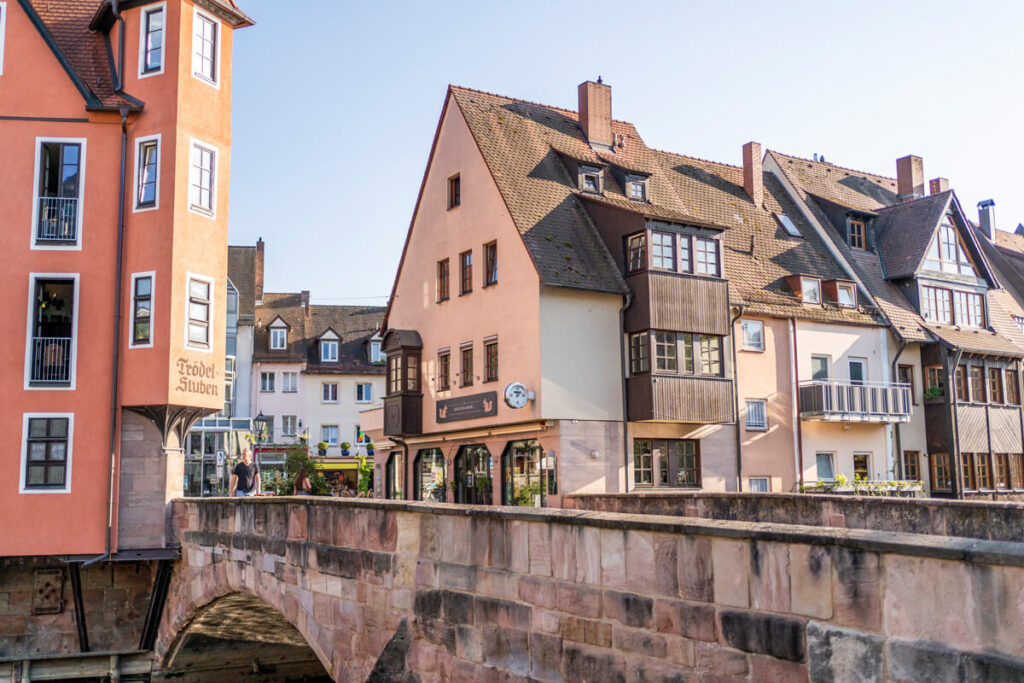
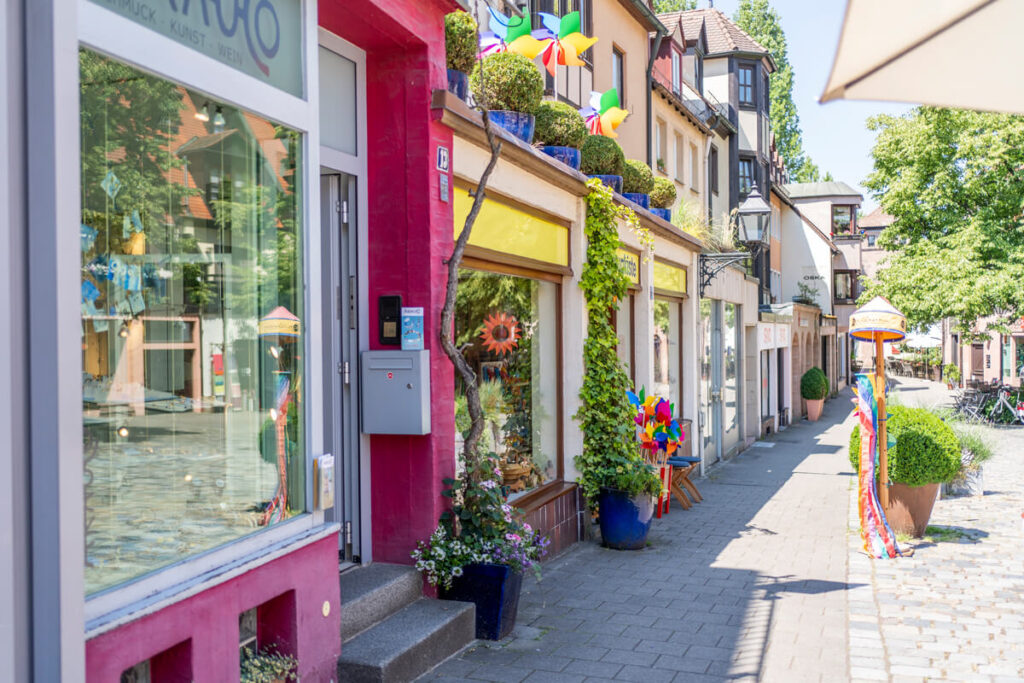
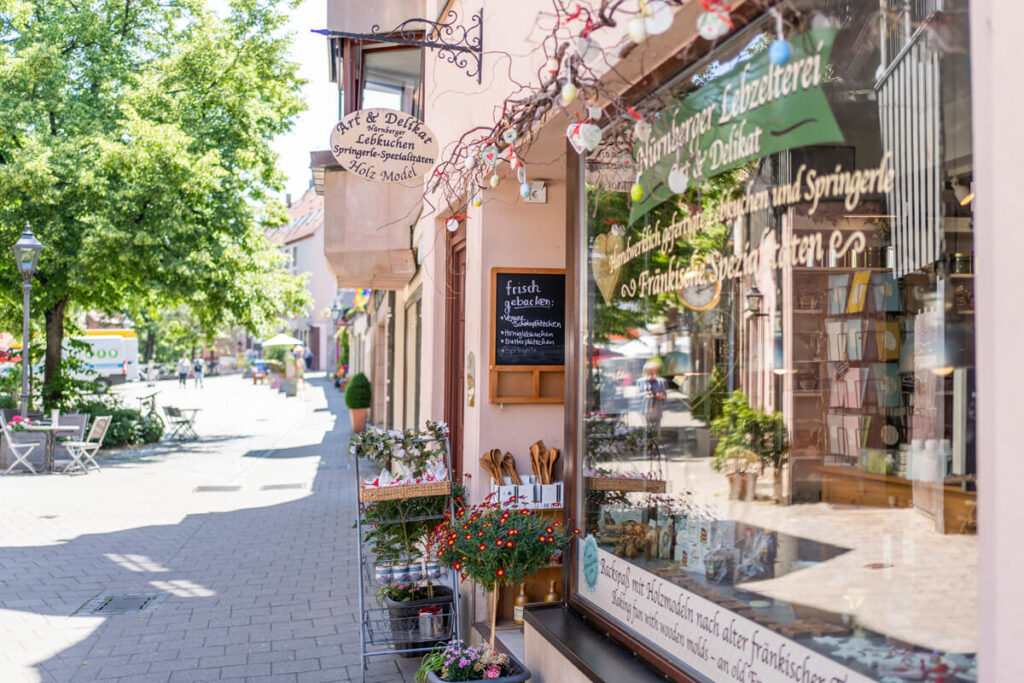
9. Deutsches Museum
Not far from the flea market is the Deutsches Museum, one of our absolute favorite museums in all of Germany. Everything here revolves around our future and the question of how we will live in 10, 20, and 50 years. The so-called “Future Museum takes you into the world of cyborgs, smart cities, and outer space. Many fantastic installations and interactive stations, as well as over 250 exhibits, bring the future to life here in the museum. The themes are our future in everyday life, in technology, in space, and in the city. Be sure to plan a visit to this museum, it’s well worth it!
- Address: Augustinerhof 4, 90403 Nuremberg
- Opening hours: Tuesday to Sunday from 10 a.m. to 6 p.m.
- Admission prices: €9.50 for adults | reduced 6 € (order tickets here)
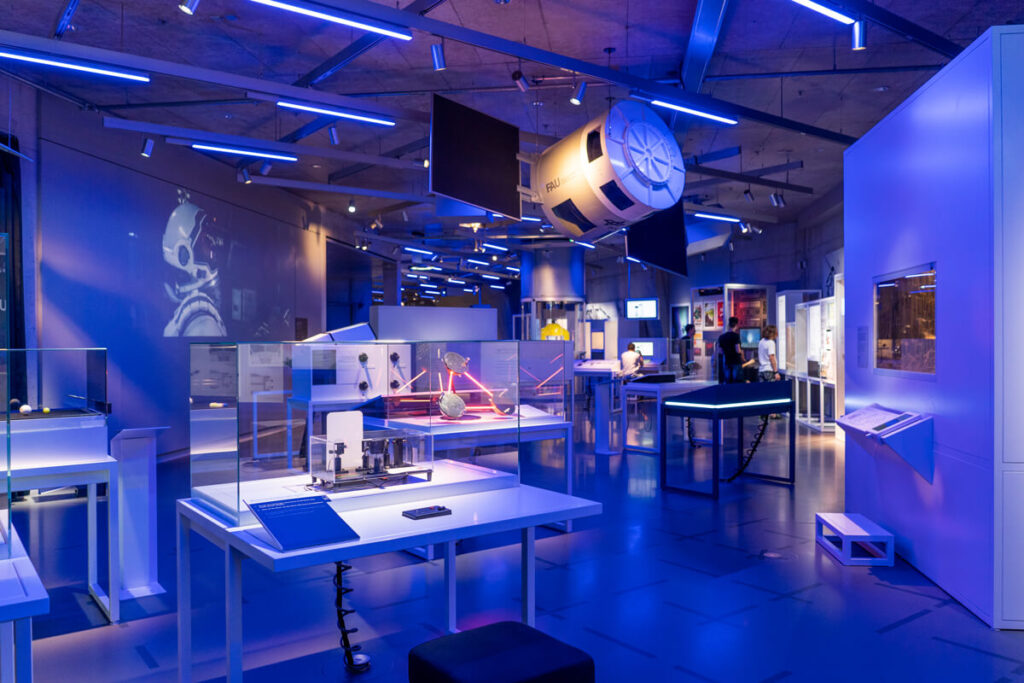
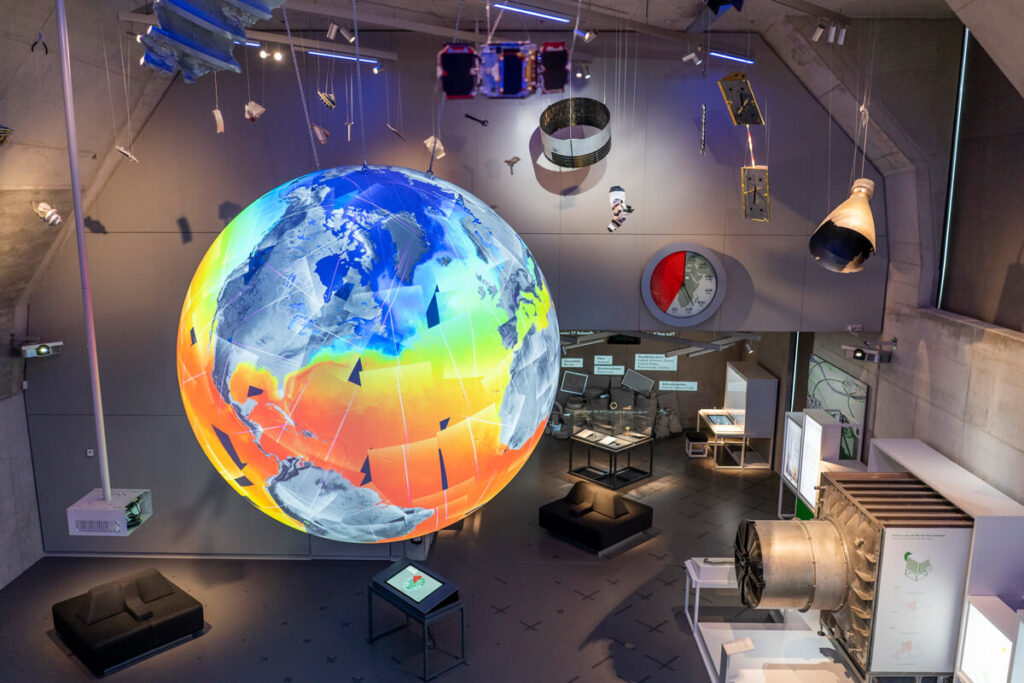
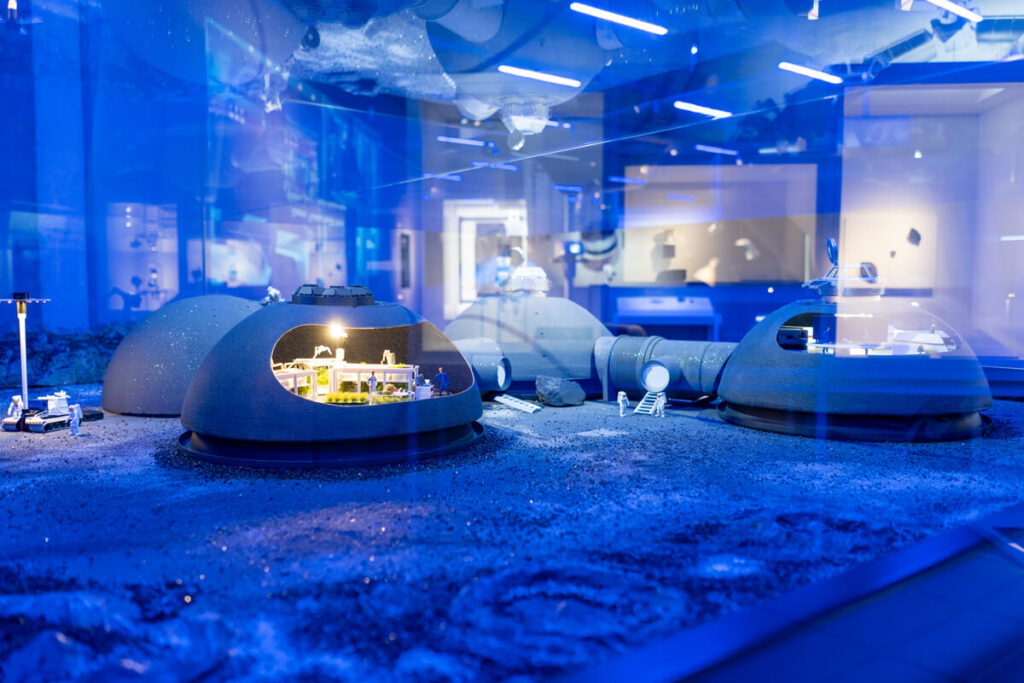
10. Historic Chain Bridge
The historic Chain Bridge, often simply referred to as the Chain Bridge, is a 68-meter-long pedestrian bridge connecting the districts of St. Lorenz and St. Sebald over the Pegnitz River. Built in 1824, the Chain Bridge is one of the oldest bridges in Nuremberg. According to Wikipedia, it is even considered “the oldest surviving iron chain bridge in continental Europe” (source: Wikipedia). The area around the Chain Bridge is very quiet, green, and idyllic. From there, you can take a leisurely stroll to the Hallerwiesen meadows and relax in the Café Schnepperschütz.

11. Main Market Square with Frauenkirche
As you explore the city, sooner or later you will pass by the large Main Market Square. The central square in the heart of the Old Town is a historic trading center that has played an important role in the city for centuries. At Nuremberg’s Main Market Square, you’ll find a variety of market stalls offering a wide range of products, including fresh fruit and vegetables, meat, fish, baked goods, flowers, spices, handicrafts, souvenirs, and much more. The market is especially famous for its Nuremberg bratwurst.
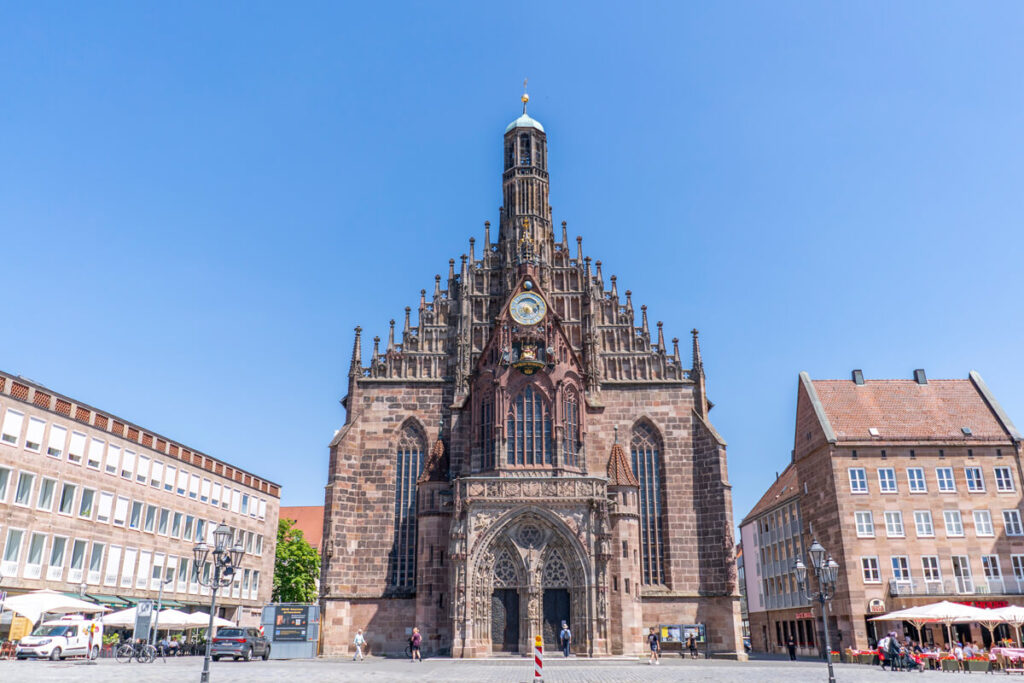
One of the most notable features of the Main Market Square is the “Schöner Brunnen” (Beautiful Fountain). This impressive fountain is a Gothic masterpiece, built in the 14th century. Richly decorated with figures, ornaments, and reliefs, it serves as a popular meeting place and photo opportunity. Nuremberg’s main market square is also home to the famous Christkindlesmarkt, one of the most famous and traditional Christmas markets in Germany. More on that later. Also worth a visit is the impressive Frauenkirche, which dates back to the 14th century.
10. Street of Human Rights
The “Street of Human Rights” with its museum is located near the Kornmarkt and is a symbolic and pictorial representation of the Universal Declaration of Human Rights adopted by the United Nations. The Street of Human Rights is a promenade with 27 steles, each representing an article of human rights.
Each stele displays the respective article in German and another language to emphasize the universal importance of human rights. Right next door is the Germanisches Nationalmuseum, where you can experience an exciting journey through 600,000 years of European art, culture, and history.
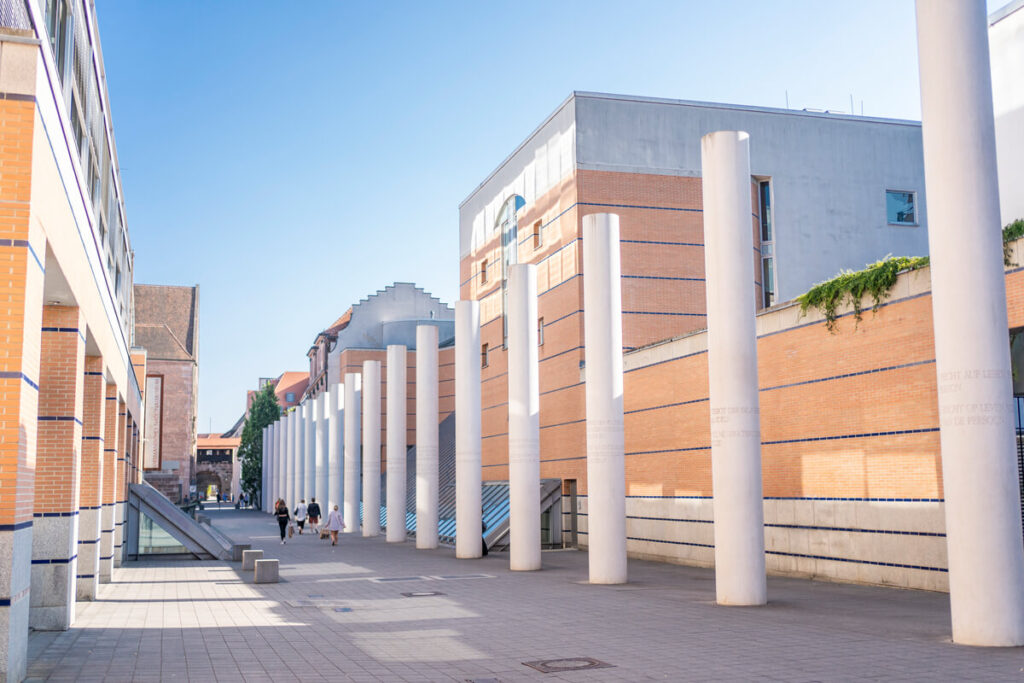
11. Handwerkerhof
The historic and popular Handwerkerhof is located right at the entrance to the Old Town. It offers insight into traditional crafts and the way of life of past centuries. The Handwerkerhof is a kind of open-air museum and a reconstruction of a medieval crafts district. The buildings are constructed in the traditional half-timbered style and convey an authentic picture of life and work in bygone times.
It houses various workshops and studios of artisans practicing traditional crafts. You can watch the artisans at work and purchase products such as ceramics, jewelry, wood carvings, leather goods, and much more. The Handwerkerhof also houses cozy restaurants and cafés where you can enjoy regional specialties and traditional dishes. We recommend, among other things, the Café in the 12th.
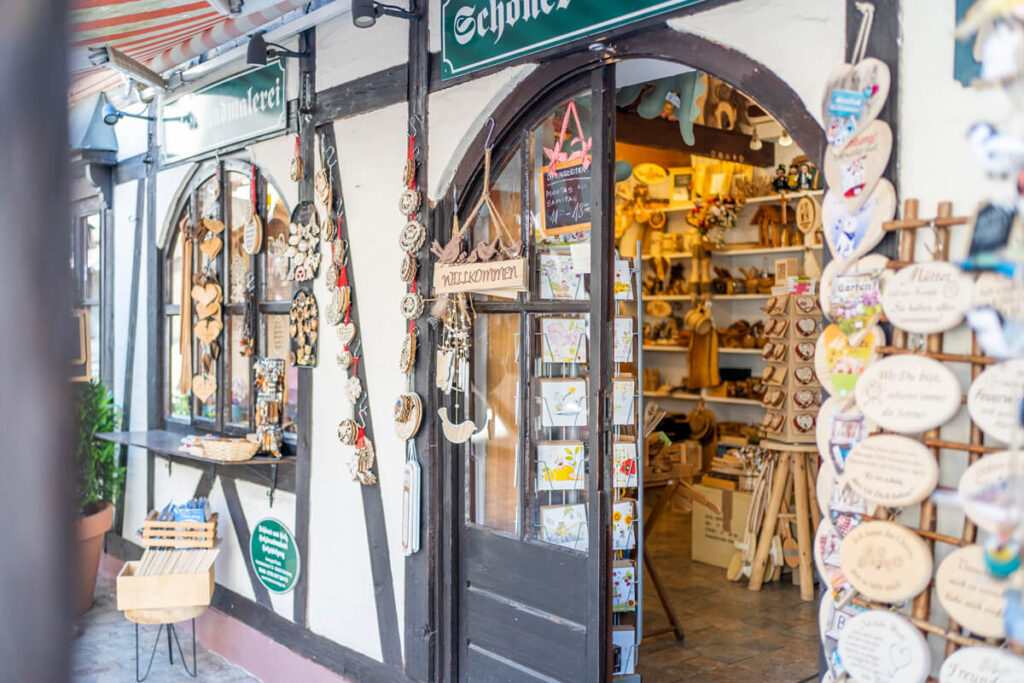
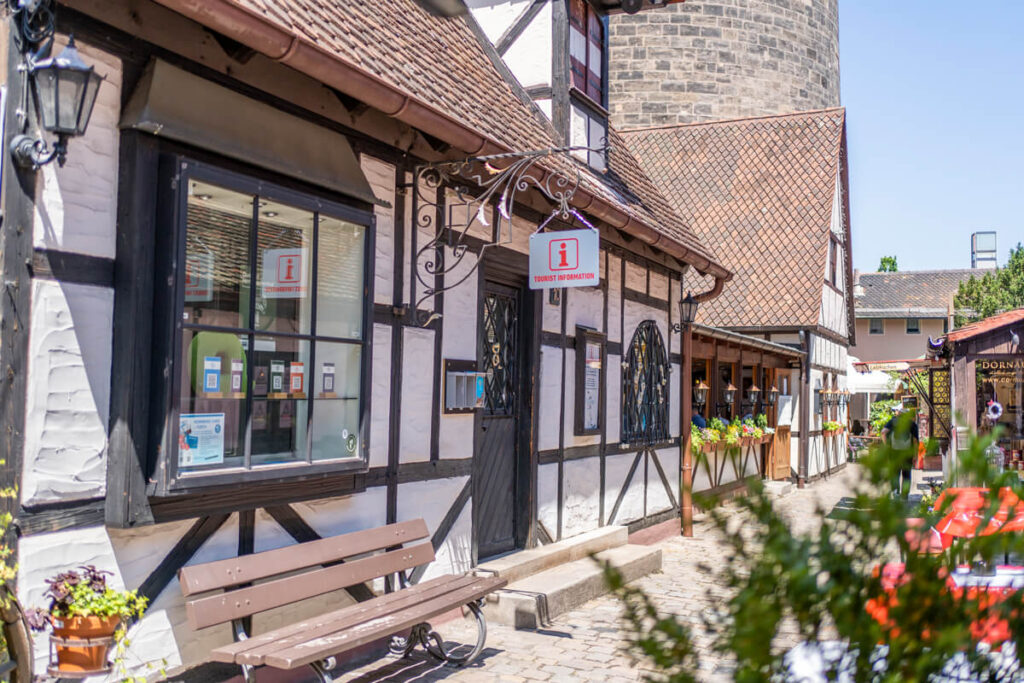
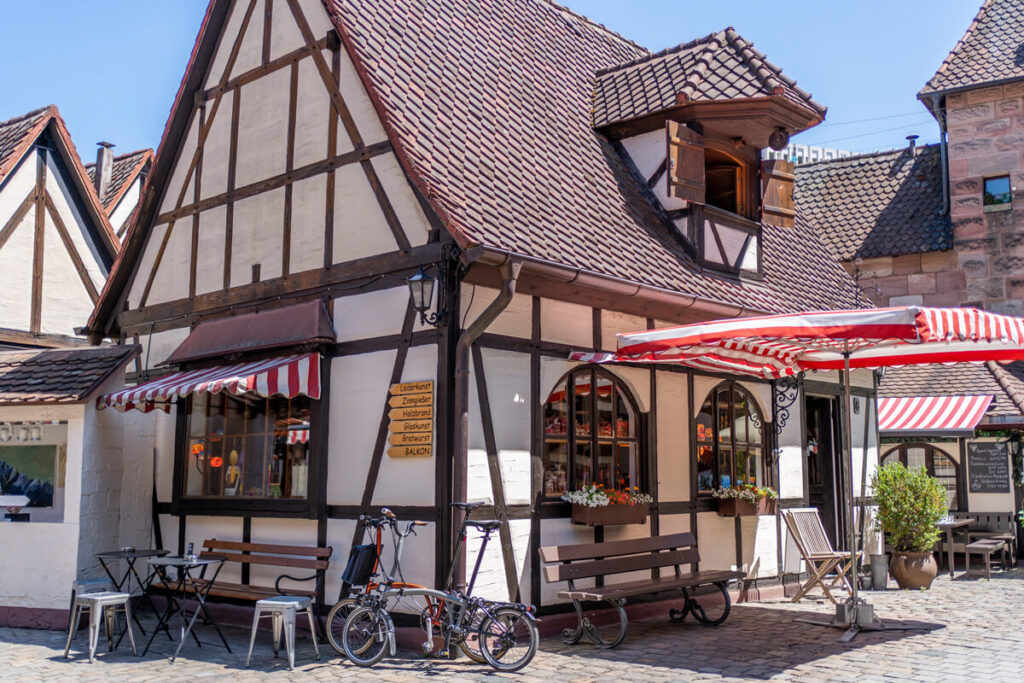
12. Holy Spirit Hospital
Another favorite photo spot for us is the Holy Spirit Hospital, which is best seen from the Museumsbrücke. This former hospital was the largest social institution in Germany in the Middle Ages and offered support to the needy, the elderly, and the disabled. The Imperial Crown Treasure was also kept here for almost 400 years. Today, the Holy Spirit Hospital is used, among other things, as a retirement home.
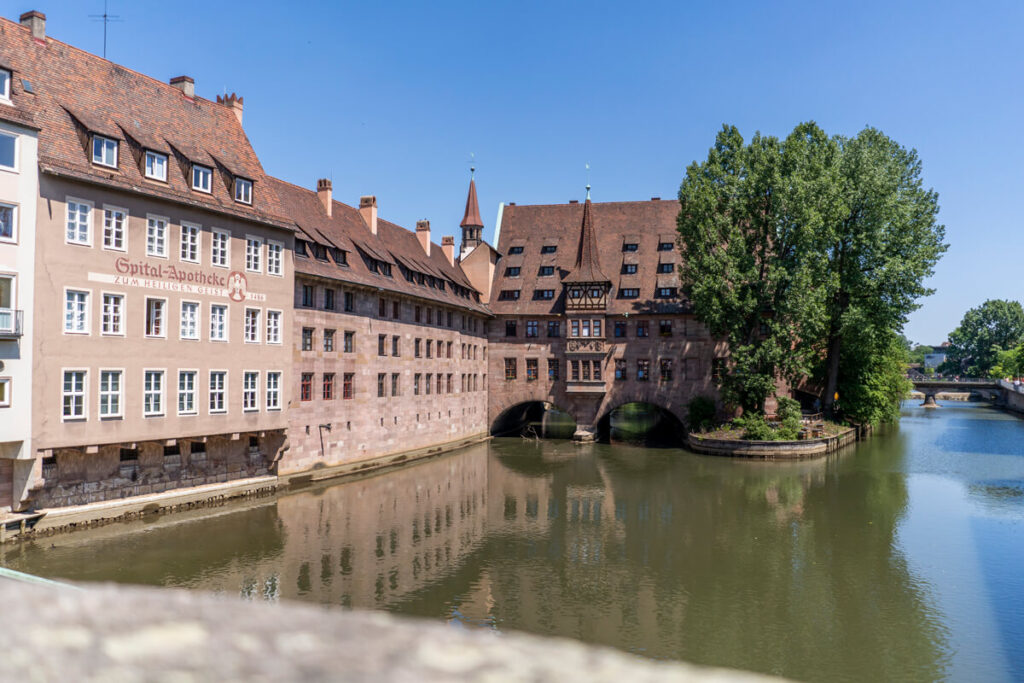
13. Jakobsmarkt Quarter
During our exploration of Nuremberg, we also discovered the Jakobsmarkt Quarter and several sights. These include the White Tower (now a subway station), the imposing St. Elisabeth Church, the Marriage Carousel (Hans Sachs Fountain), St. Jakob’s Church, and the historic Bratwurst Kitchen, which dates back to 1419. By the way, there’s a golden pig sitting on the roof.
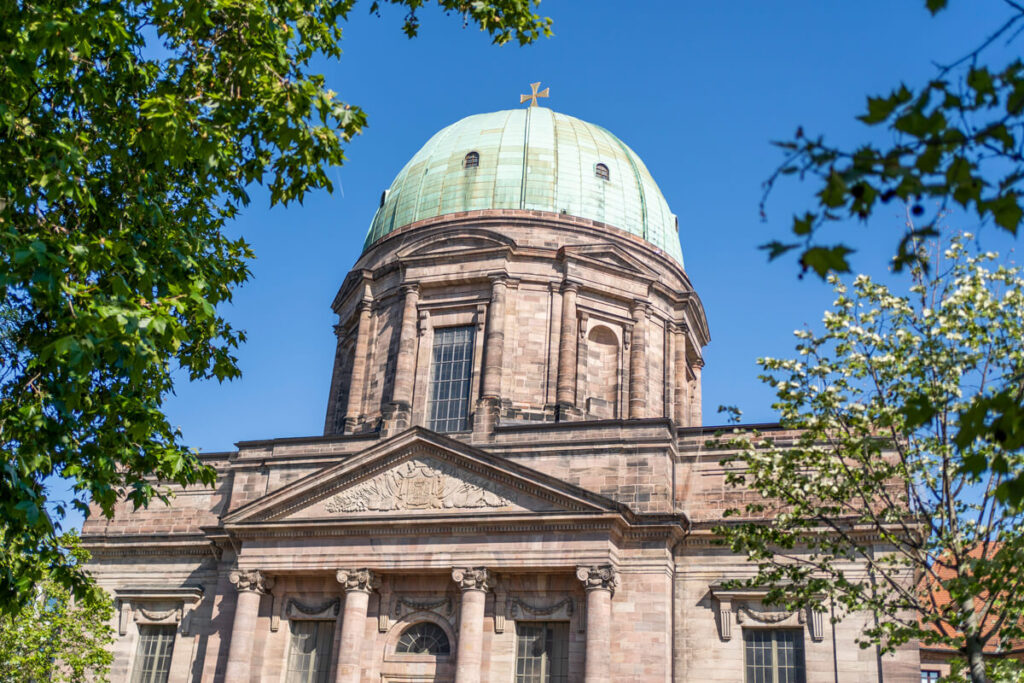
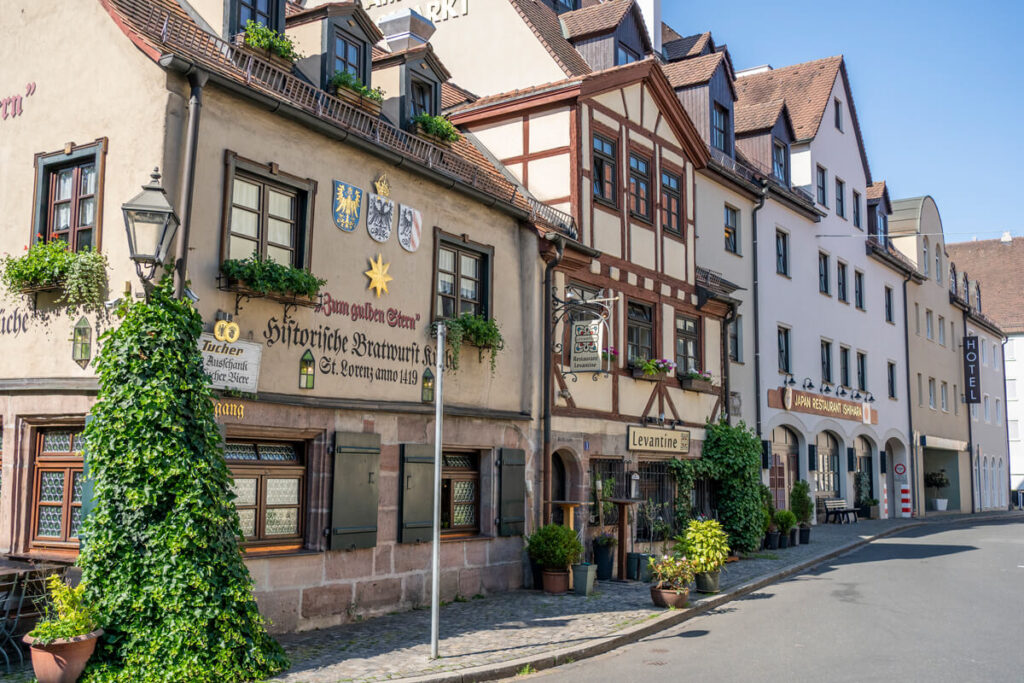
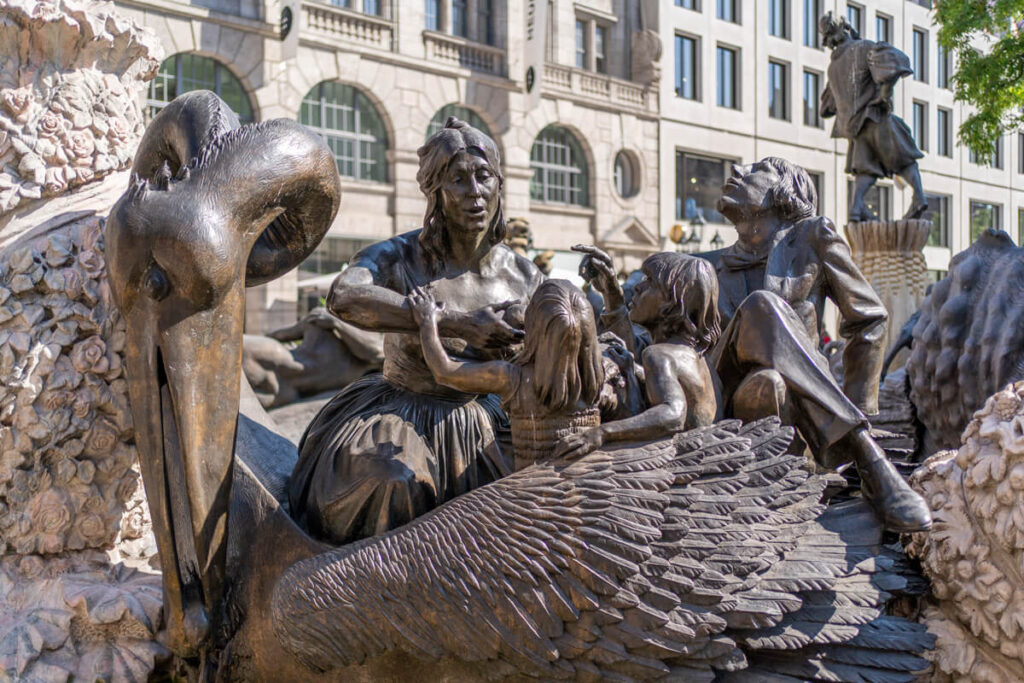
14. St. Johannis Cemetery
It may sound strange, but for us, the St. Johannis Cemetery is one of the top attractions in Nuremberg. This historic cemetery is one of the oldest in the city and is known for its historic tombstones, artistic sculptures, and its significance as a cultural and historical monument. The famous German artist Albrecht Dürer (1471-1528) was buried in the St. Johannis Cemetery.
The cemetery houses a variety of historic tombstones, sculptures, and monuments from different eras. The countless flowers scattered across all the graves are particularly beautiful. I don’t think we’ve ever seen a more beautiful cemetery. The cemetery is located on Johannisstraße and is open daily from 7 a.m. to 7 p.m.
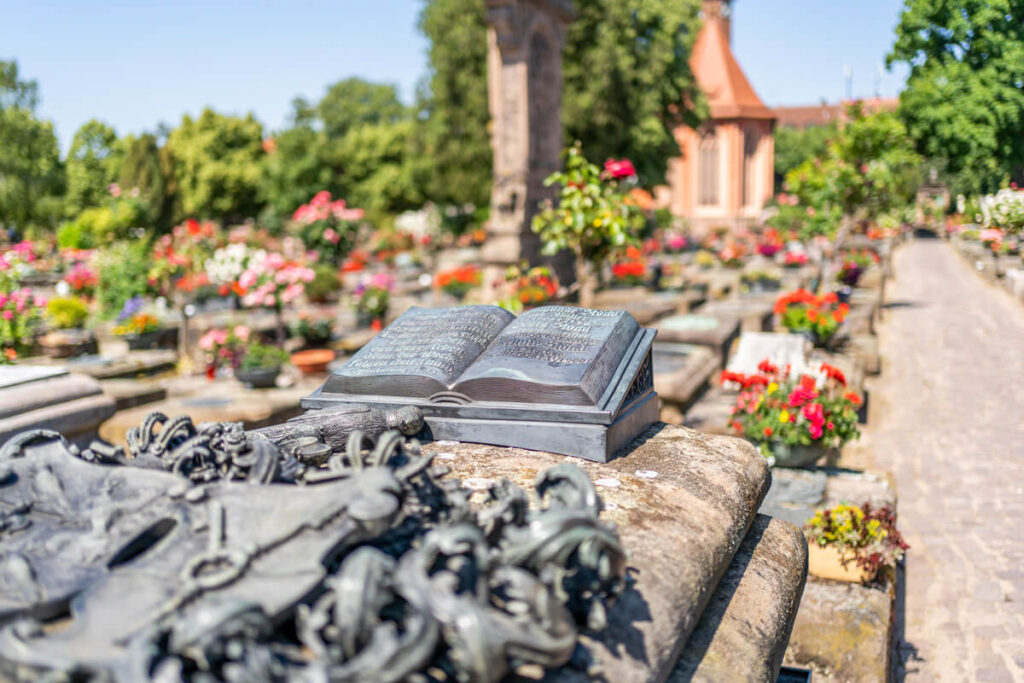
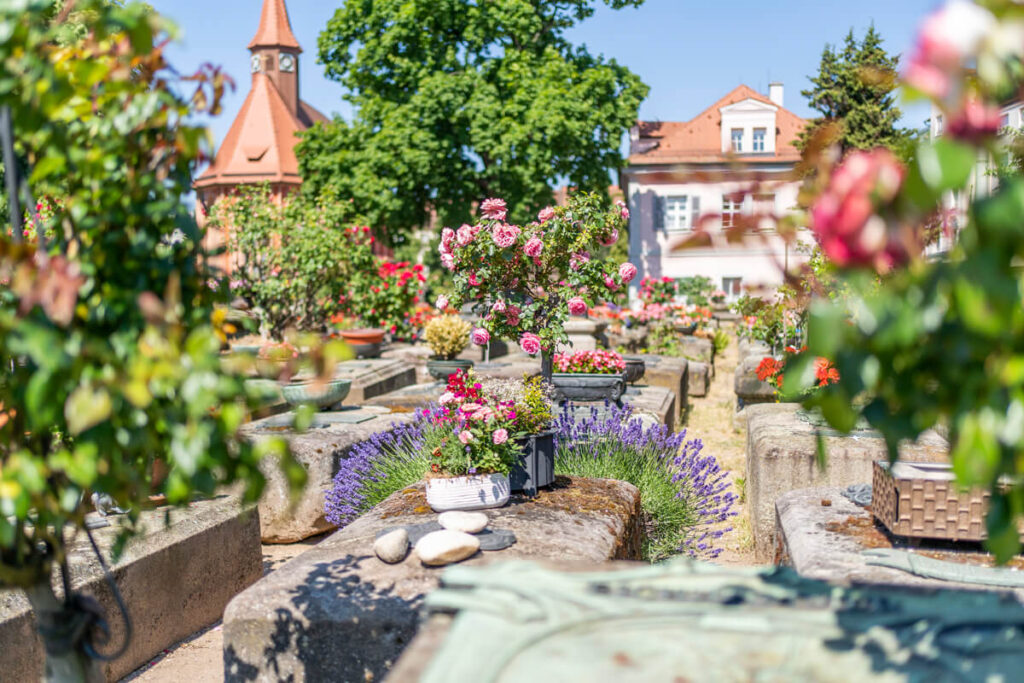
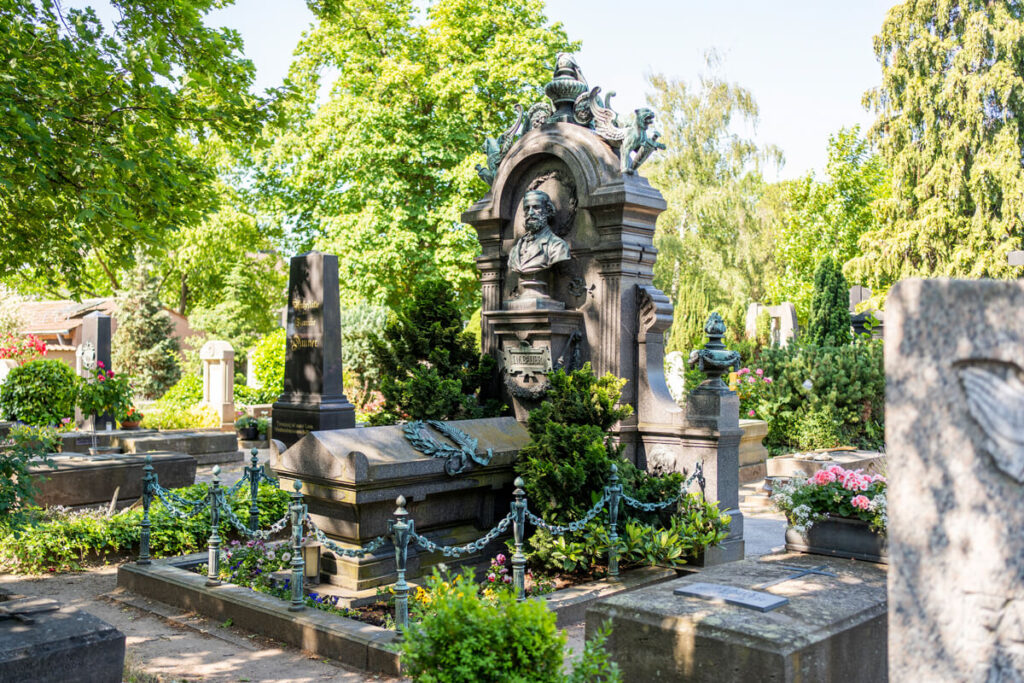
15. Hesperides Gardens
On the way to St. Johannis Cemetery, you’ll pass another small oasis. The Baroque-style Hesperides Gardens were already a gem for those seeking relaxation and are still a popular destination today for those seeking peace and quiet. In the Baroque gardens, you’ll find not only a wide variety of plants, but also sculptures, fountains, benches, and the remarkable sundial made of small boxwood bushes. The park is open daily from 8 a.m. to 8 p.m. from April to October.

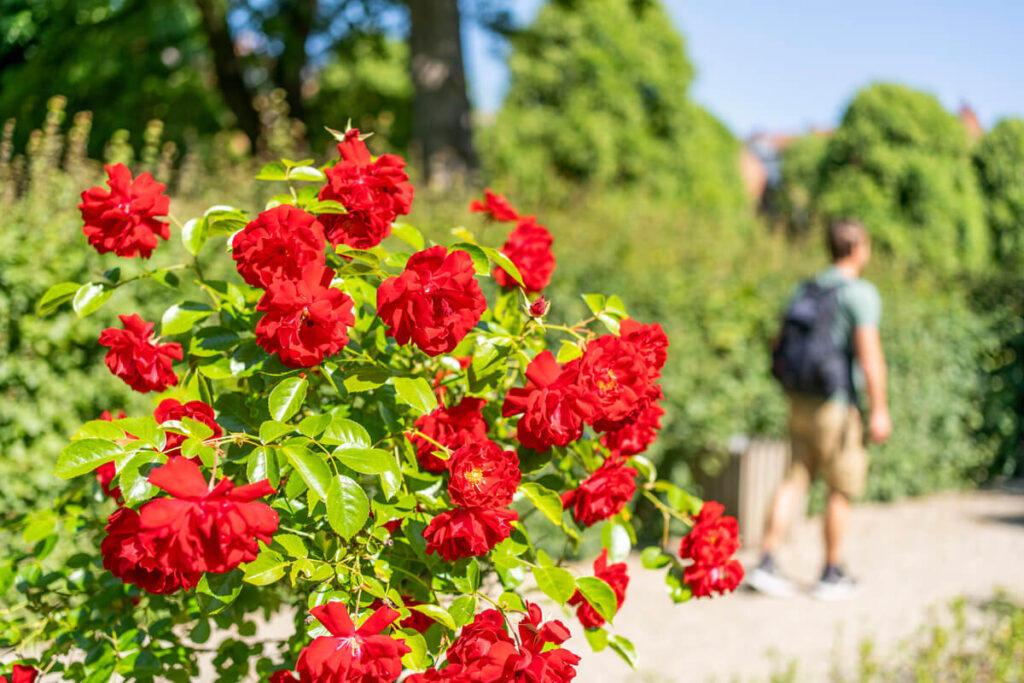
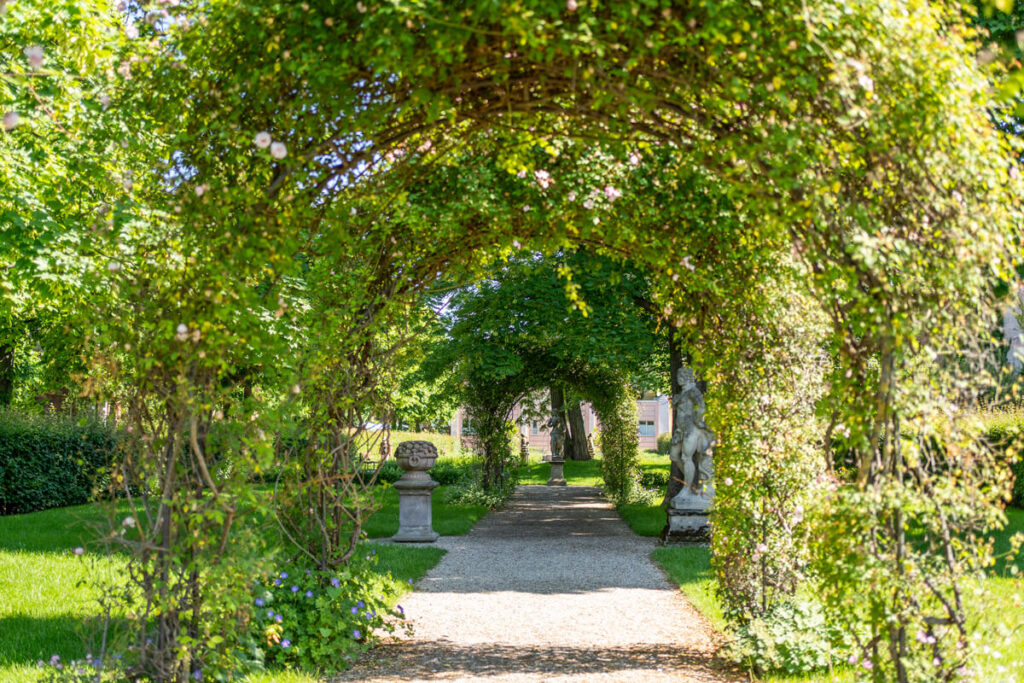
Nuremberg’s Neighborhoods + Web App
We explored the city with the “Nuremberg Neighborhoods” web app and highly recommend it. It lets you discover not only the city’s well-known sights, but also new, lesser-known corners. You’ll receive interesting information, audio, and video information about each highlight. The app also features popular photo spots, shops, restaurants, and cafés. There are also vouchers and coupon promotions that can help you save a few euros here and there. We think it’s really cool that you don’t have to download an app. Click here for the web app.
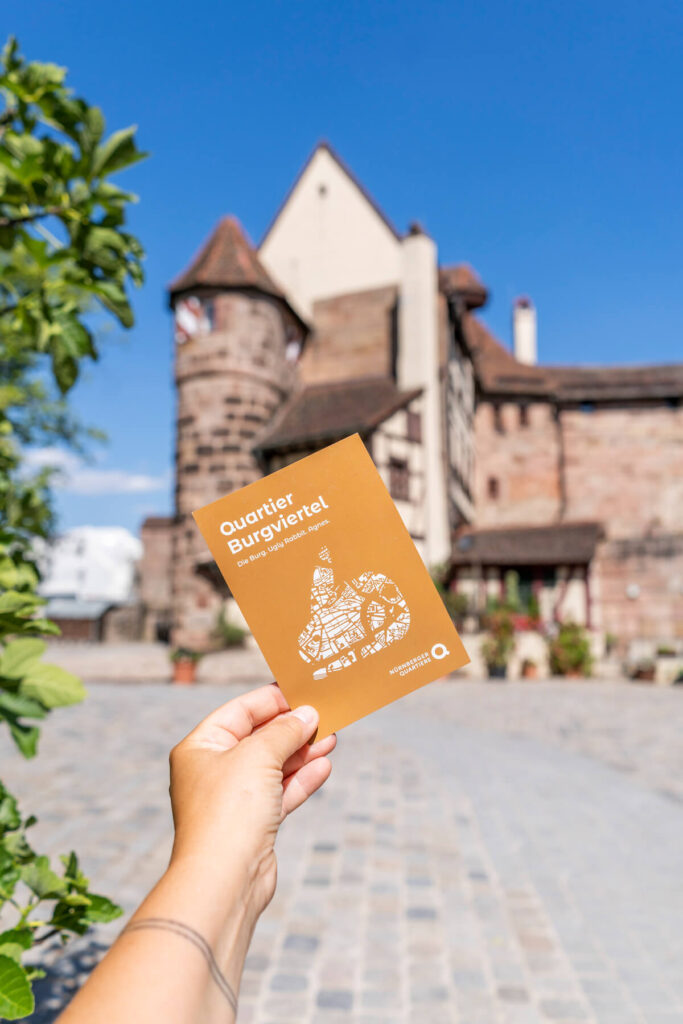
Restaurants & Cafés
We’ve been to Nuremberg several times and can therefore recommend a few restaurants and cafés. But the city has so much more to offer. We’ll explore more spots on our next visit.
Toni Travolta: In this stylish restaurant in Nuremberg’s city center, you can get super delicious pizza and pasta. The ambiance is casual, and the location is really cool!
Die Wirtschaft: Do you prefer local specialties and Franconian cuisine? Then head to the restaurant “Die Wirtschaft.” Here you can enjoy modern Franconian dishes and freshly tapped beer.
Bruderherz: The Bruderherz is not only a modern city hotel, but also a restaurant and brewery. Here you can expect traditional and down-to-earth dishes, which have been given a completely new interpretation.
Altstadthof Brewery: Beer lovers, gourmets, and whiskey fans will all get their money’s worth at this traditional brewery. First visit the historic rock passages and then make yourself comfortable in the restaurant with beer garden.
Schnepperschütz: On your way to the Hesperidengärten and St. Johannis Cemetery, you’ll pass the Schnepperschütz. Outside the small café at the Hallertor, you can enjoy sandwiches, beer, and a great atmosphere when the weather is nice.
The Small Ice Cream Factory: Delicious ice cream is also a must on a city tour. We recommend the “little ice cream factory” on Weißgerbergasse. The ice cream specialties are lovingly made by hand using organically certified ingredients.
BERGBRAND Coffee Roastery: Fancy some good cake and delicious coffee in a relaxed atmosphere? Then head to the BERGBRAND Coffee Roastery on Weißgerbergasse.
Café Wanderer & Bieramt: Enjoy your after-work drink or nightcap at Café Wanderer & Bieramt at Tiergärtnertor. This is where the city meets in the evening to end the day in a relaxed atmosphere.
Cat Temple Nuremberg: We love cats, and of course we had to pay a visit to the Cat Temple Nuremberg. Between the coffee, cake, and other treats, a few adorable little cats roam around.
Machhörndl Bar: When we are in Nuremberg, we always go to the Machhörndl Espresso Bar at Brunnengasse 7. Here you can get delicious coffee and fresh pastries.
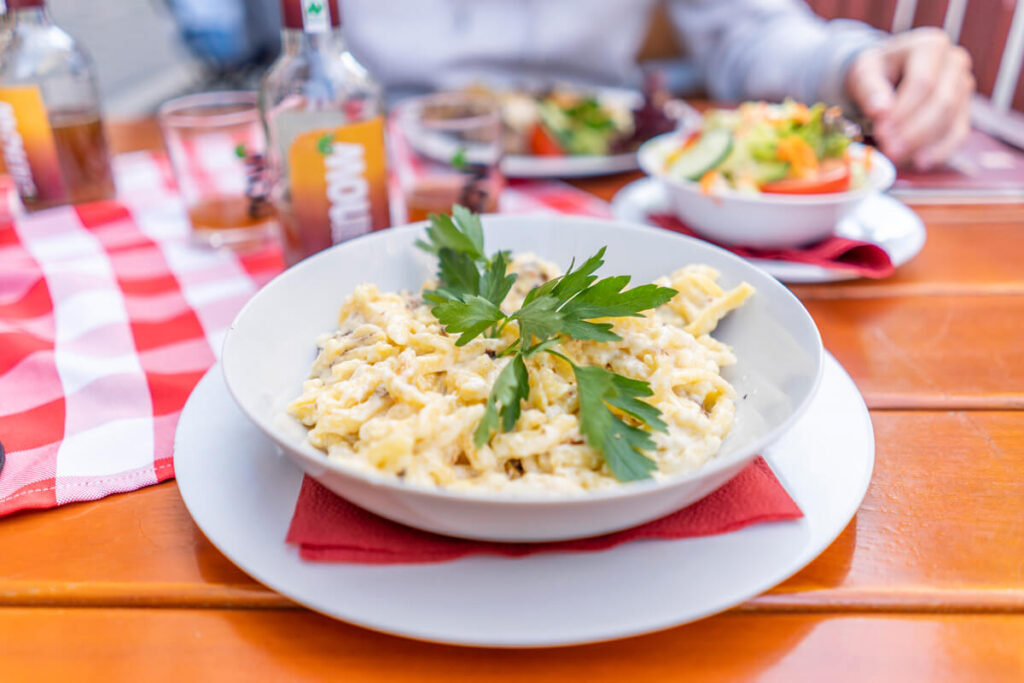
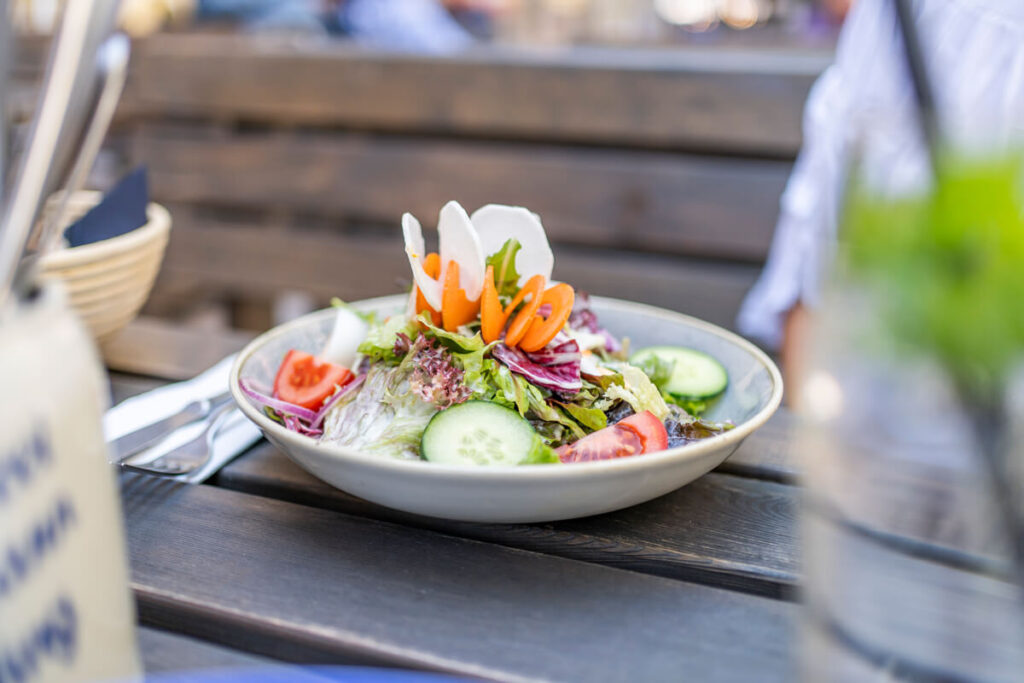
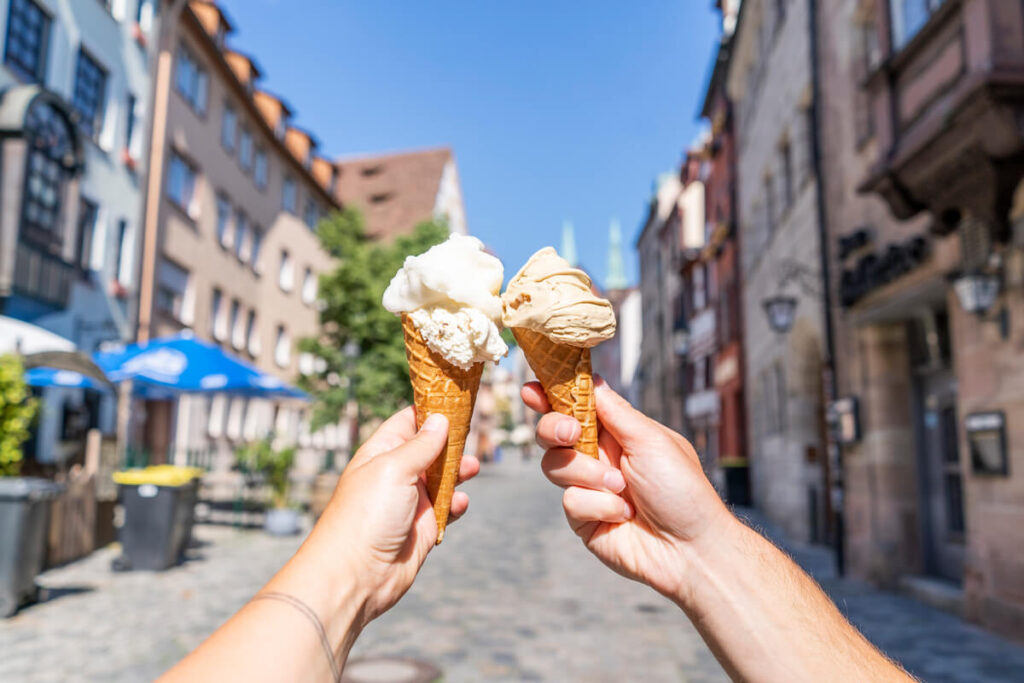
Events in Nuremberg
Christkindlesmarkt in Nuremberg: The Christkindlesmarkt in Nuremberg is one of the most famous and traditional Christmas markets in Germany. It takes place annually in the It takes place from Advent until Christmas Eve and is known for its charming and festive atmosphere. More about it here.
Rock im Park: “Rock im Park” is an annual rock music festival held near Nuremberg, Germany. It is one of the largest and most well-known music festivals in the country. More about it here.
Bards’ Meeting in Nuremberg: The Bards’ Meeting in Nuremberg is an annual music festival dedicated to the diversity and quality of music from various genres (world music, folk, jazz, pop, rock, and more). More about it here.
Blue Night in Nuremberg: The Blue Night in Nuremberg is an annual arts and culture festival that transforms the city into an impressive nighttime setting of lights, installations, and creative events. It has been Germany’s largest Long Night of Art and Culture for over 20 years. More about it here.
Nuremberg Old Town Festival: The Old Town Festival is a large folk festival that transforms Nuremberg’s historic old town into a place of celebration, enjoyment, and entertainment. It offers a colorful mix of cultural events, concerts, markets, food and drink, attractions, and much more. More about it here.
Autumn Folk Festival in Nuremberg: From the end of August to the beginning of September, the Autumn Folk Festival takes place in Nuremberg. Music, parades, plenty of delicious food, fireworks, carousels, and much more await you. More about it here.
Our Hotel in Nuremberg
During our last trip, we stayed at the Hotel Viktoria*. It’s just a stone’s throw from the main train station and right next to the historic Handwerkerhof. The 4-star hotel offers 65 individually furnished rooms with a TV, comfortable double bed, bathroom with shower, desk, minibar, and air conditioning. From our room, we had a direct view of the Neues Museum. In the morning there is a rich great breakfast buffet. Book a room here*.
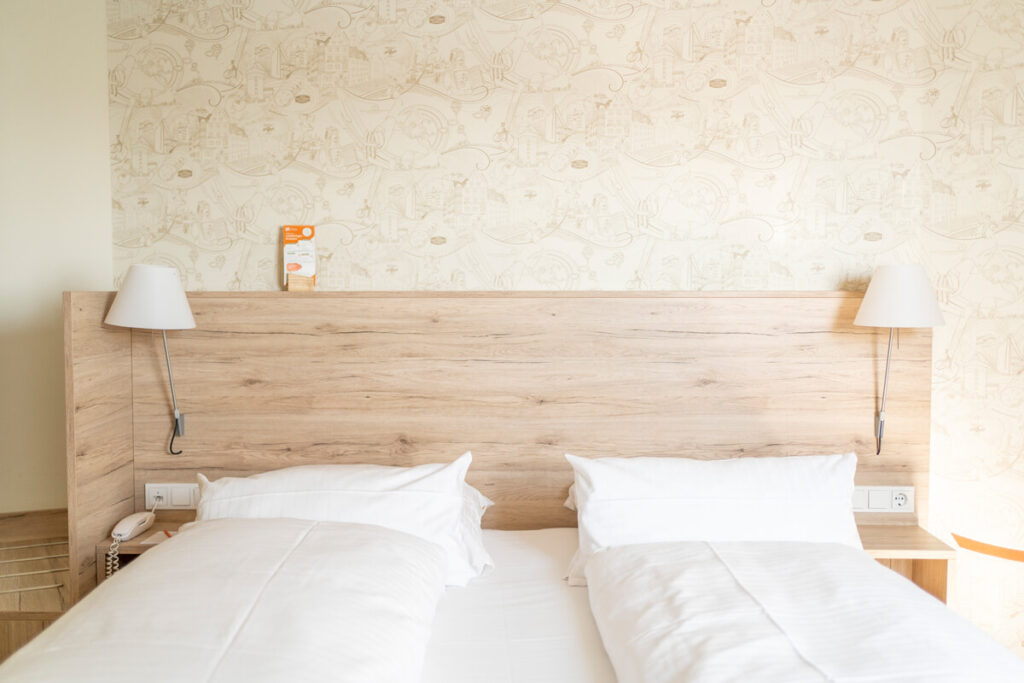
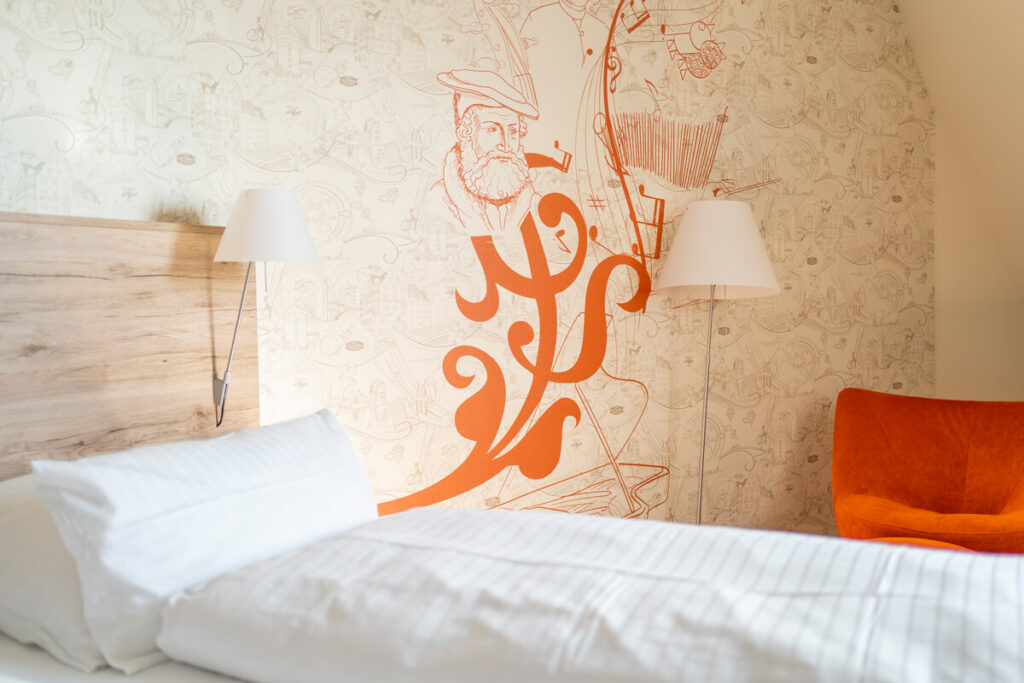
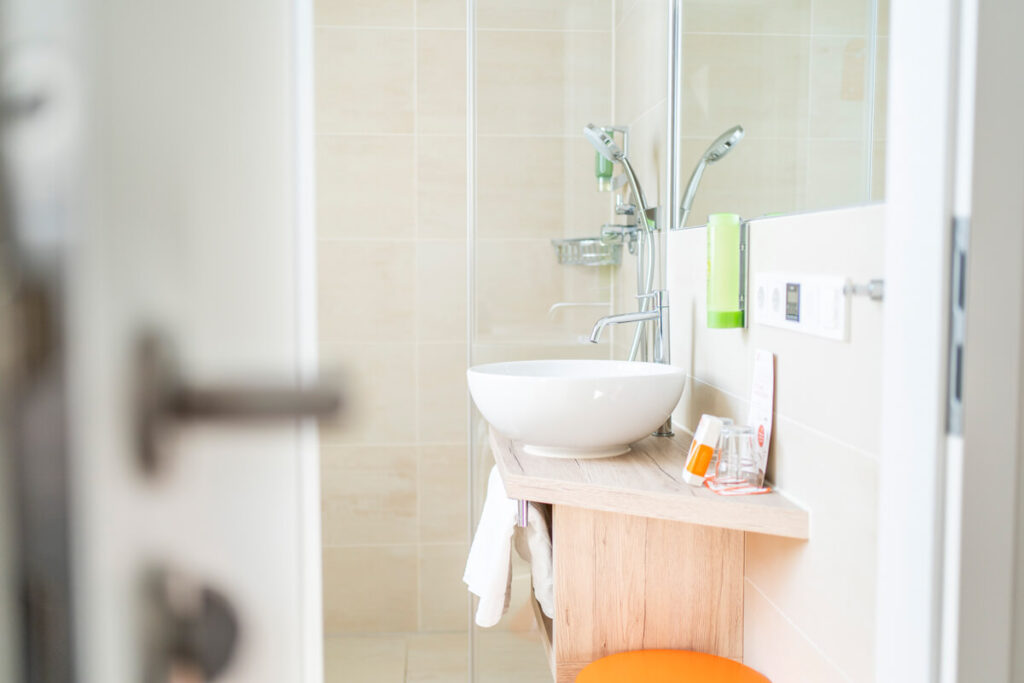
Travel tips for Nuremberg
There are various ways to get to Nuremberg, depending on where you are starting from. Nuremberg, Munich, and Stuttgart form the triangle in southern Germany. Here are the best options:
By car: Nuremberg is well connected to the German motorway network. The A3, A6, and A9 motorways all lead to Nuremberg. From Berlin, take the A9 south; from Munich, take the A9 north.
Distances to Nuremberg:
- Hamburg: 610 km
- Berlin: 450 km
- Cologne: 406 km
- Dresden: 331 km
- Frankfurt: 225 km
- Stuttgart: 212 km
- Munich: 170 km
By train: Traveling to Nuremberg by train is a convenient and environmentally friendly option. Nuremberg has a well-connected main train station, offering regular connections (RE, IC & ICE) to various cities in Germany and other European countries. Book train tickets here*.
Our Franconia Podcast
Our Franconia tour is now available for your ears. In our first episode, we talk about Coburg, Bamberg, Kulmbach, Bayreuth, and Nuremberg. Check it out!
Click the button below to load the content from www.podbean.com.
Load content